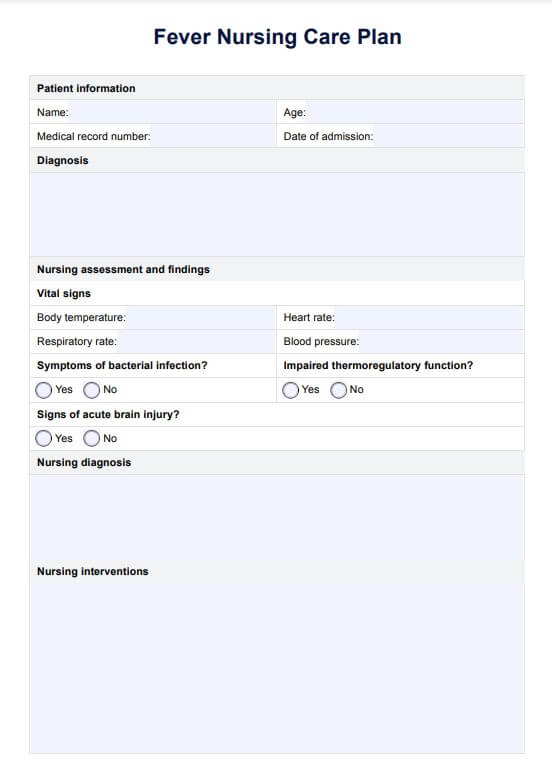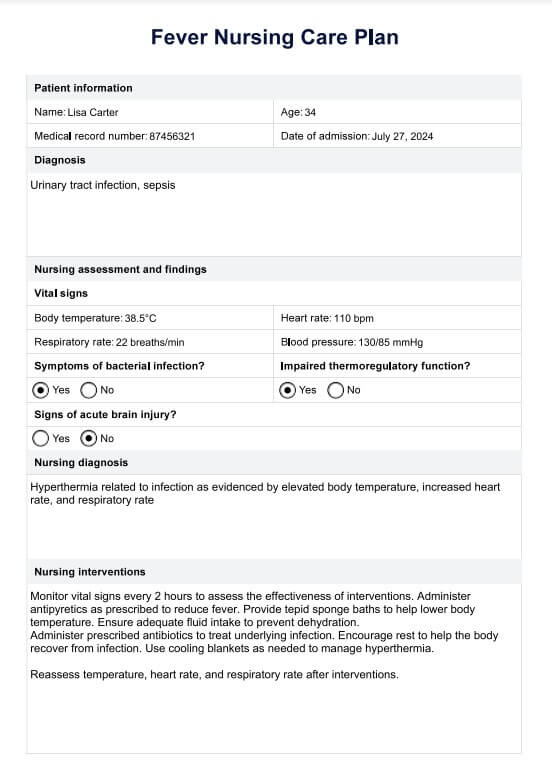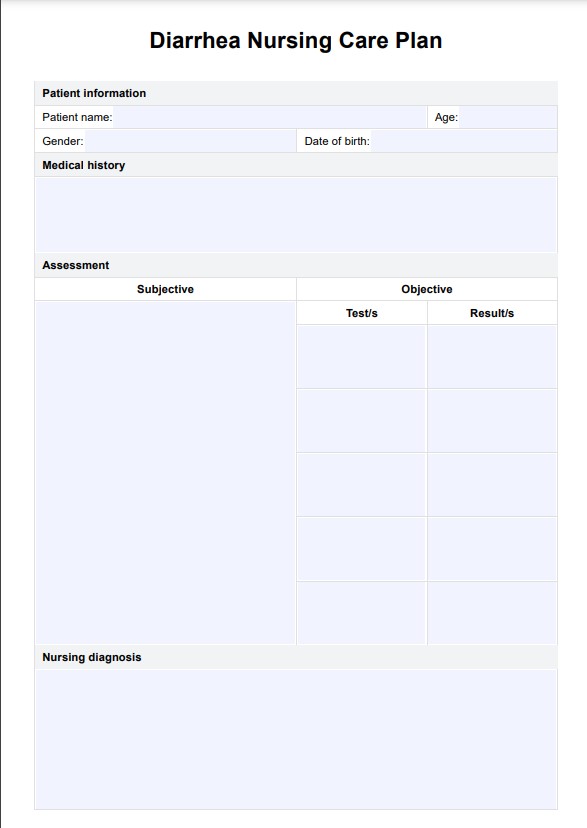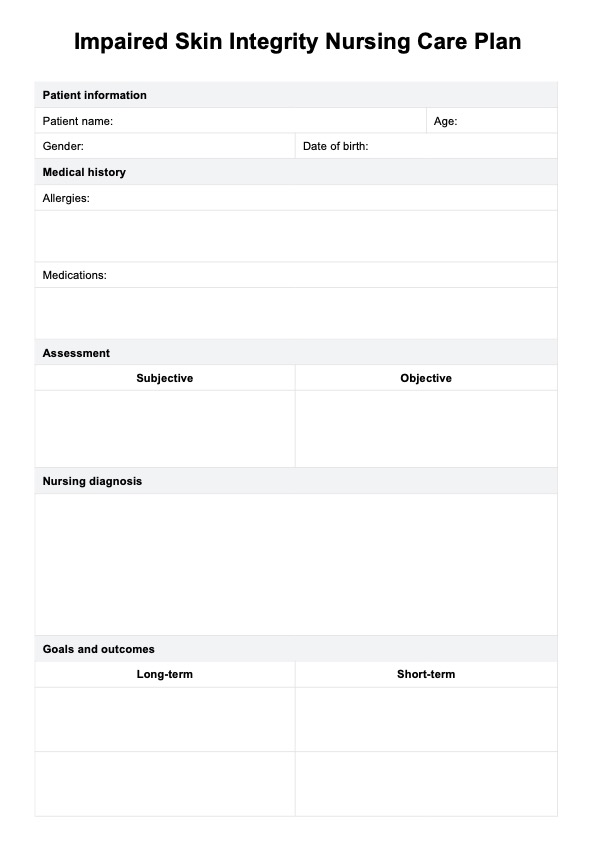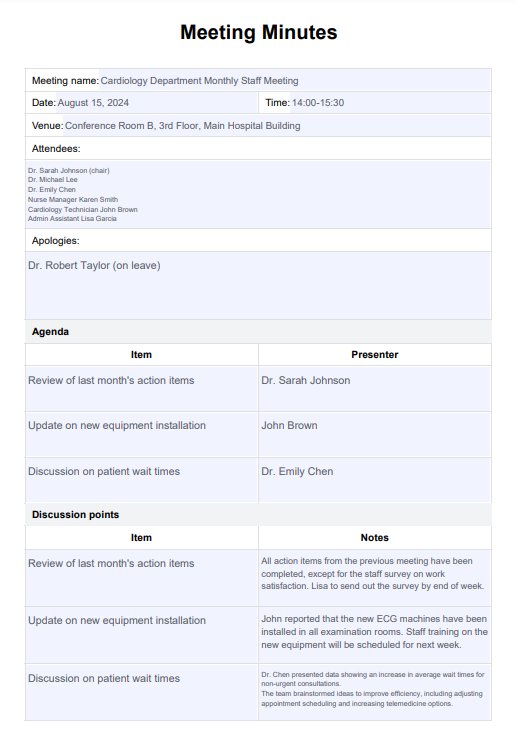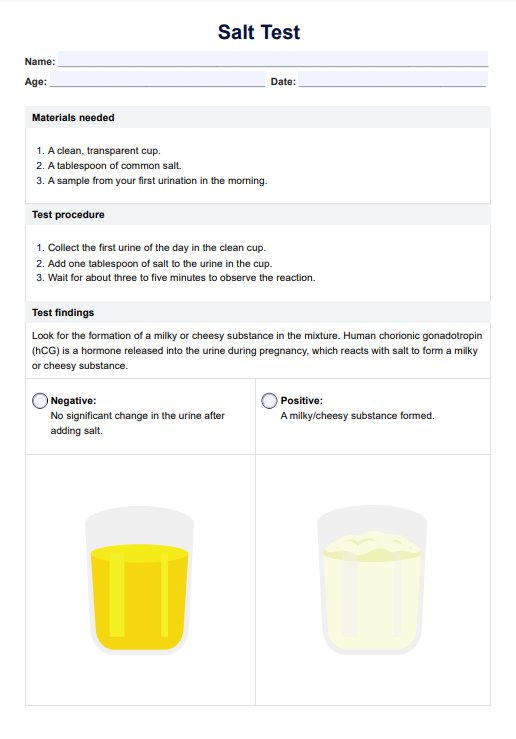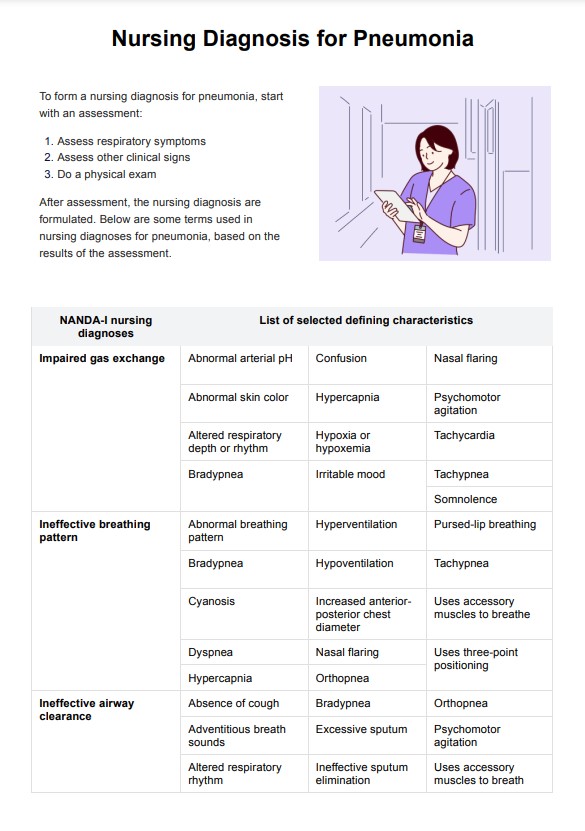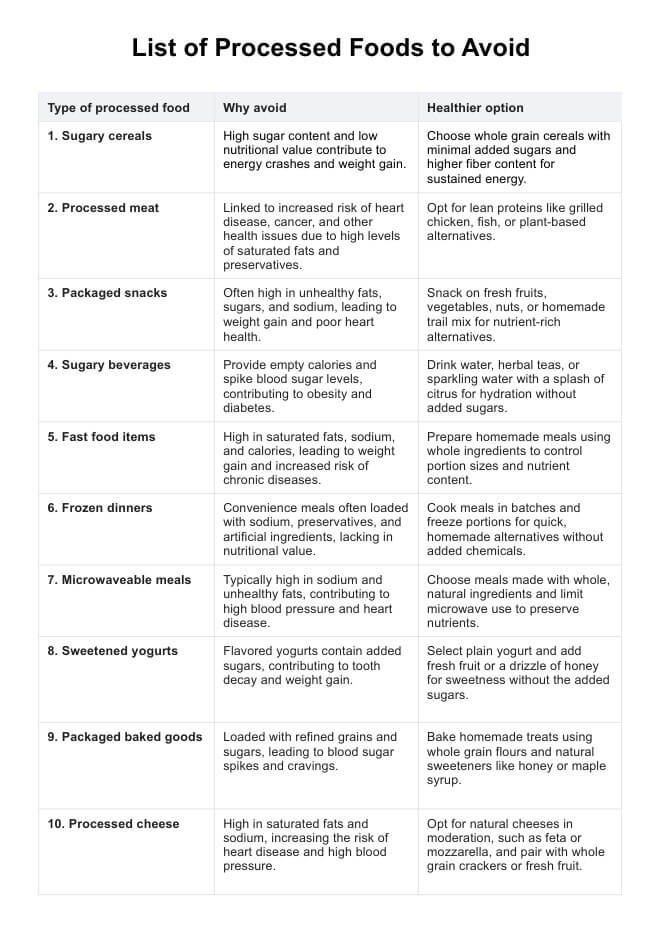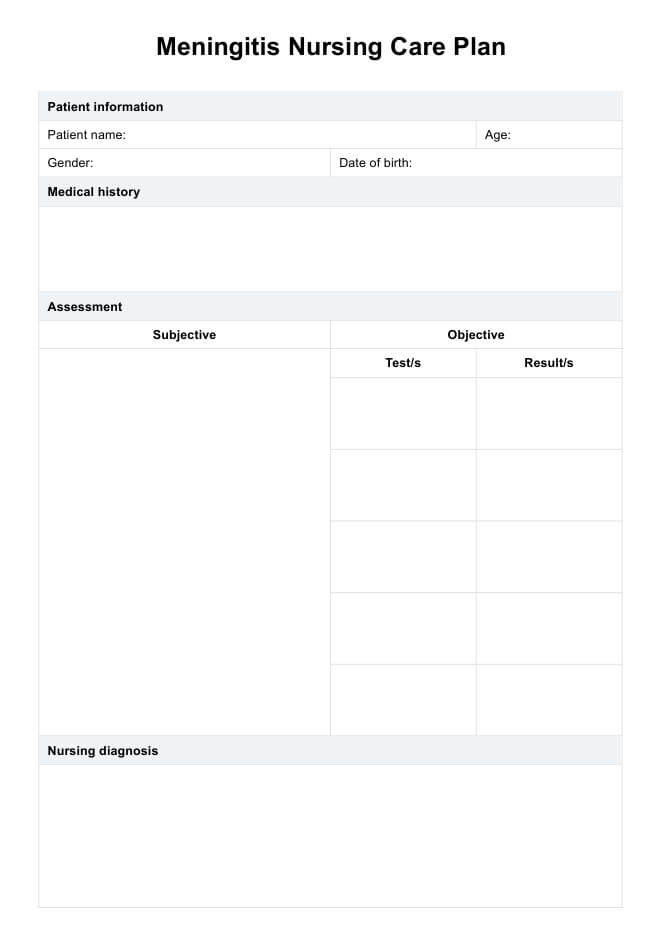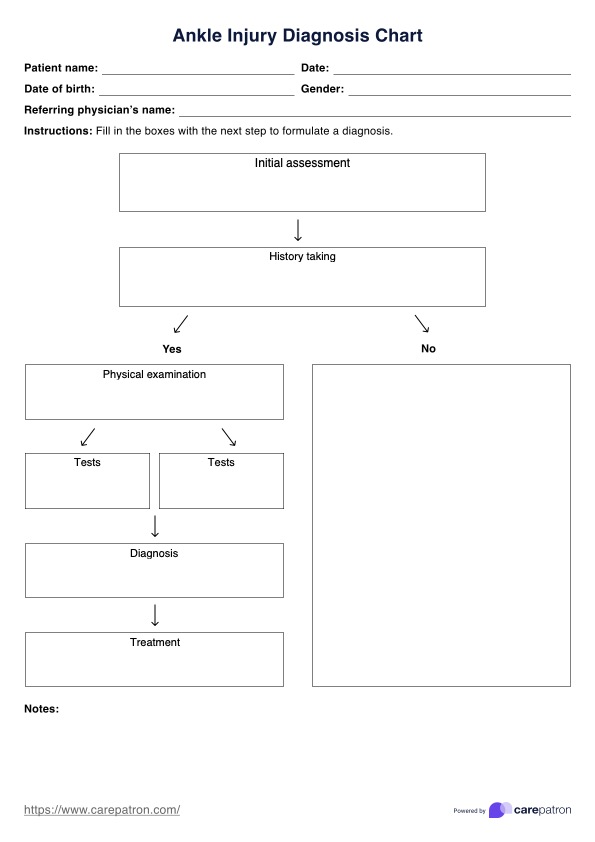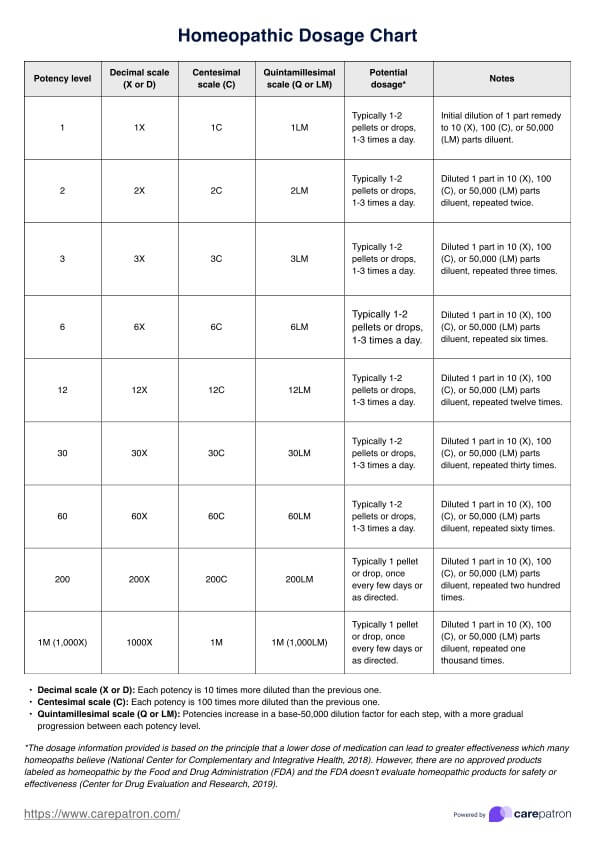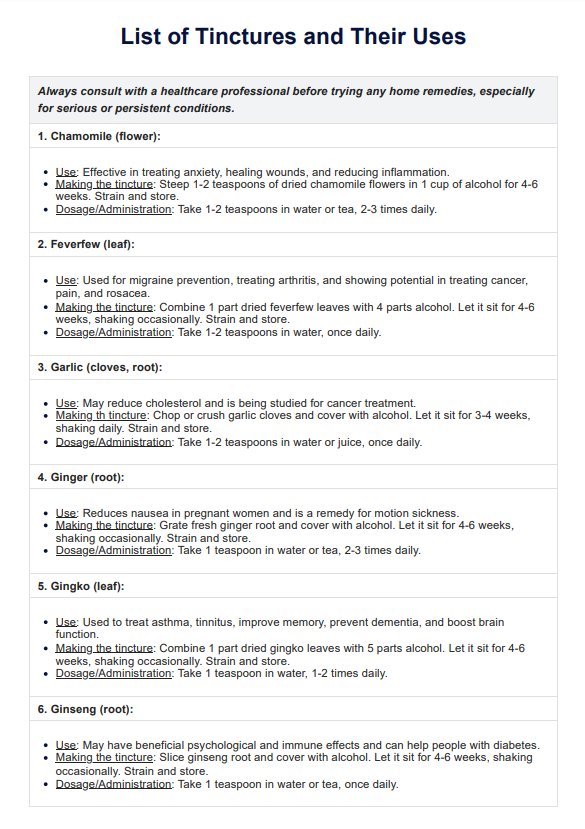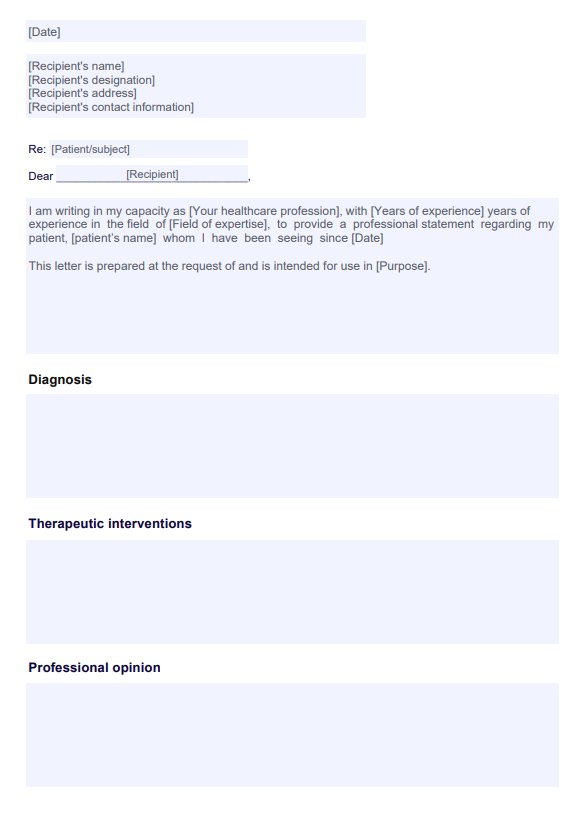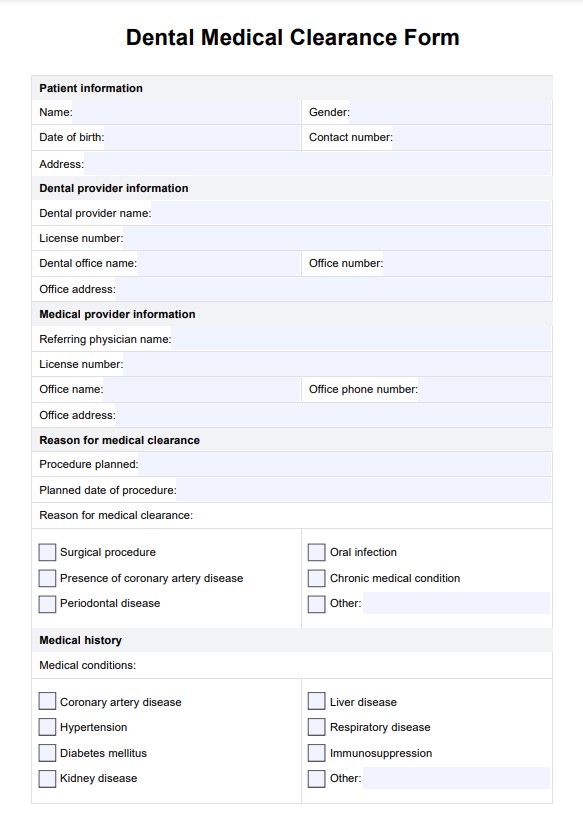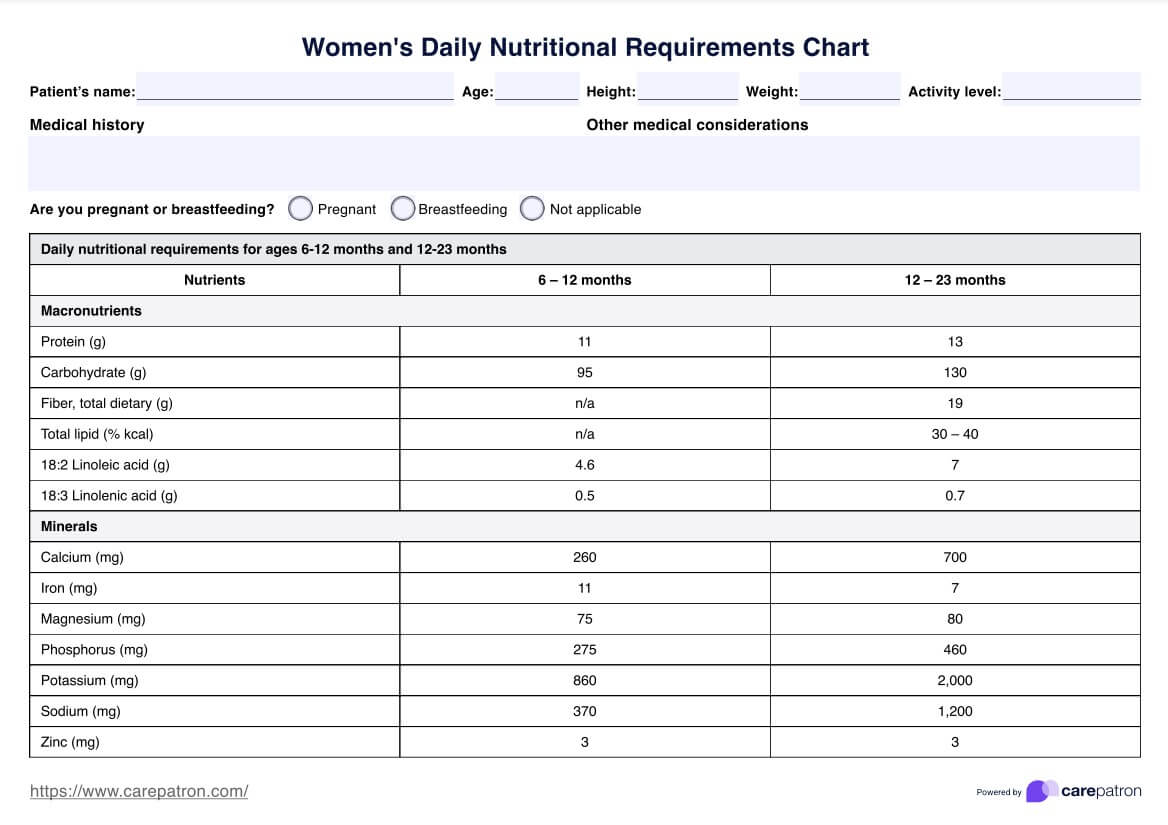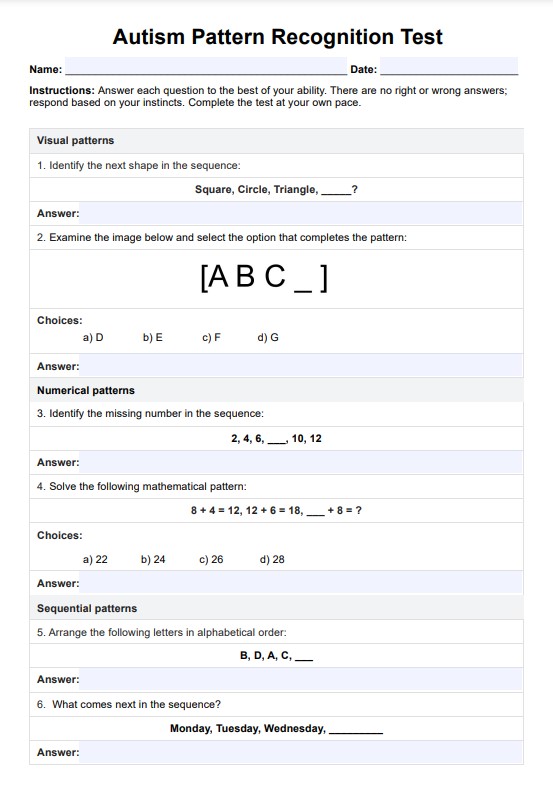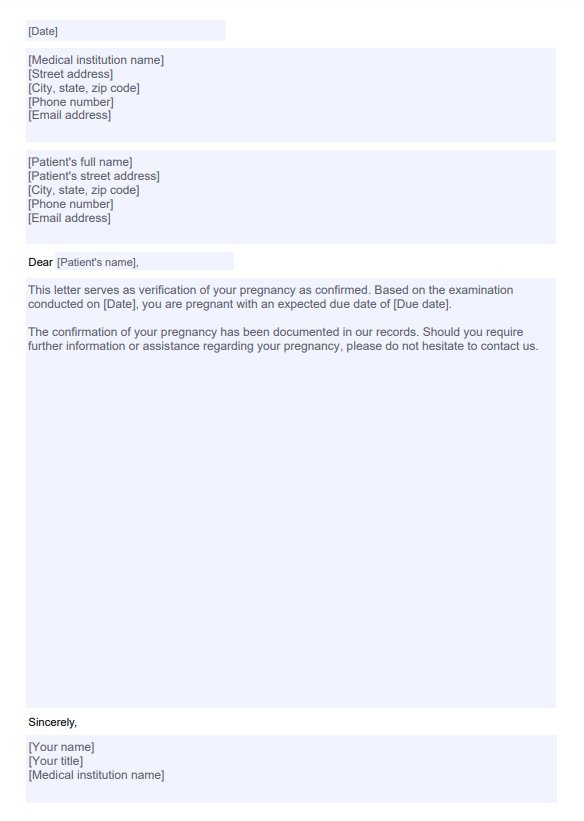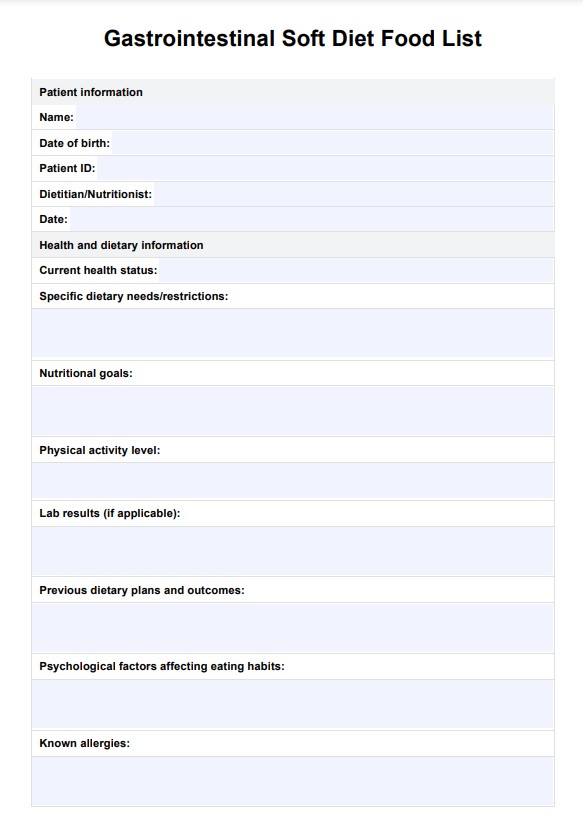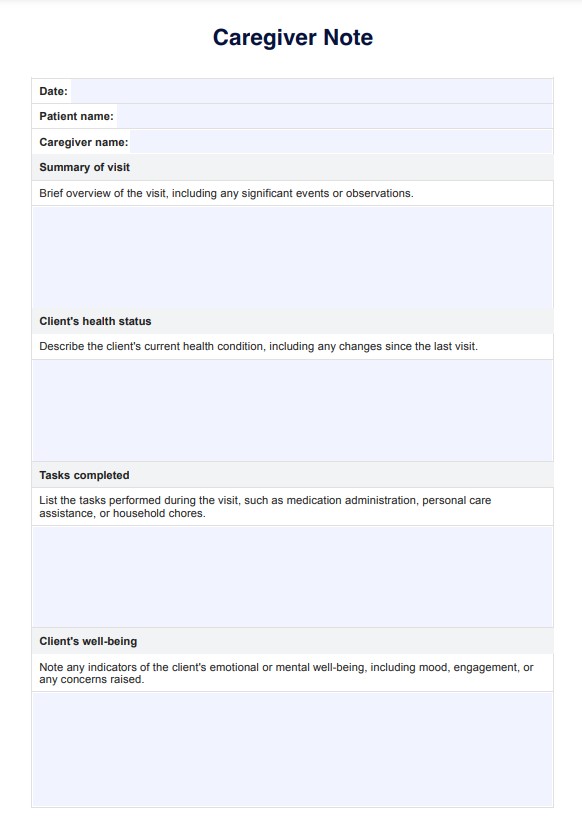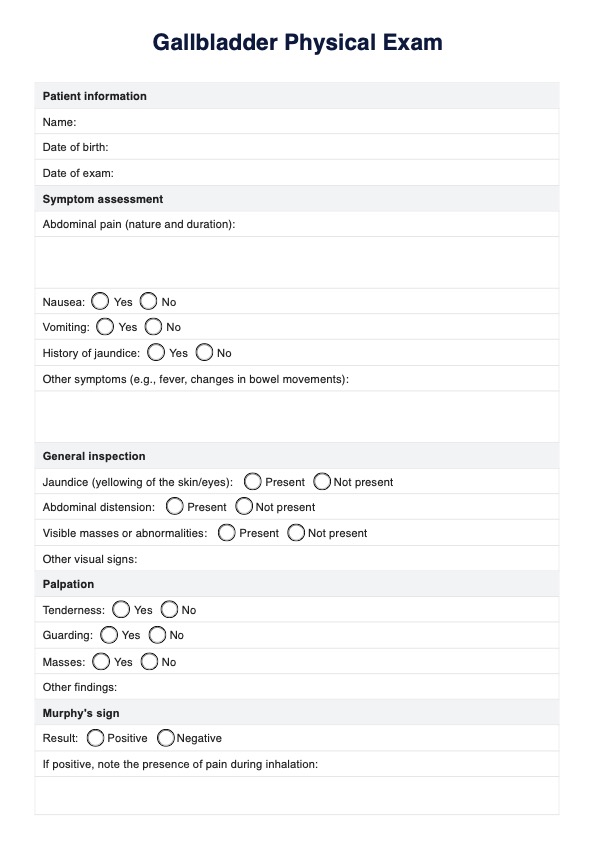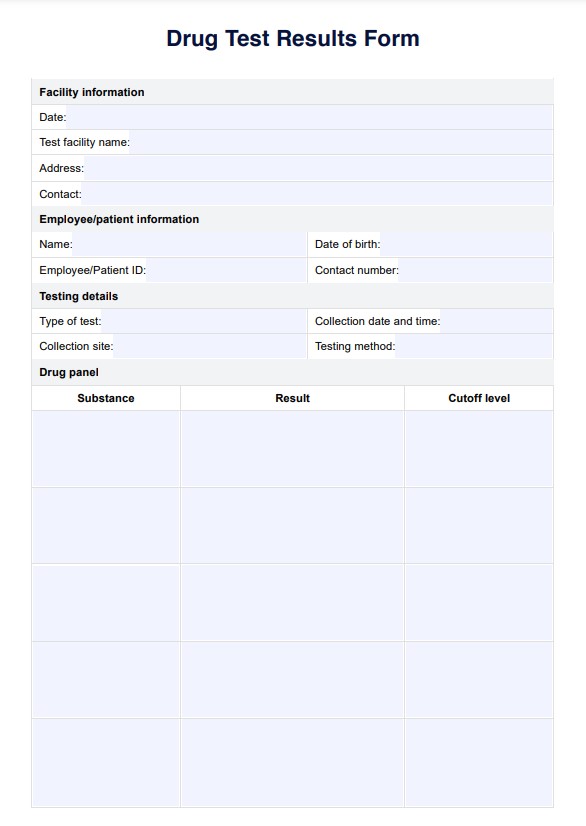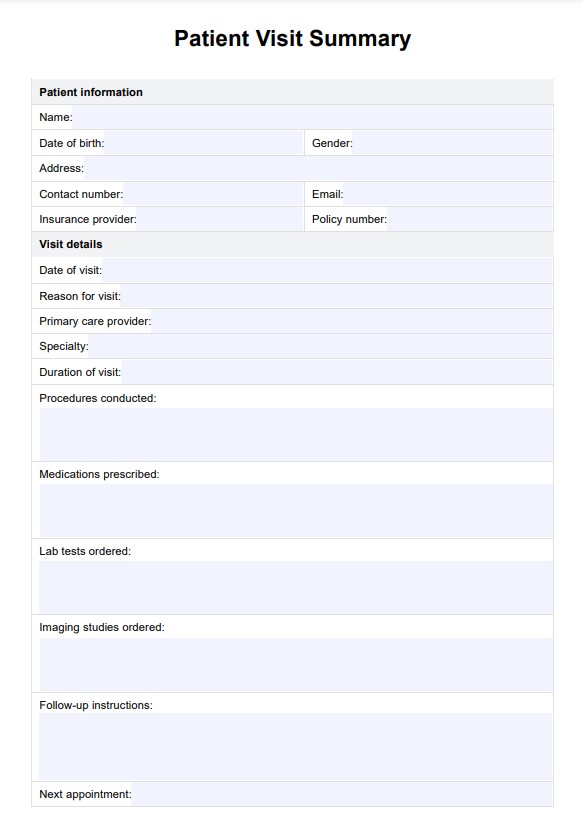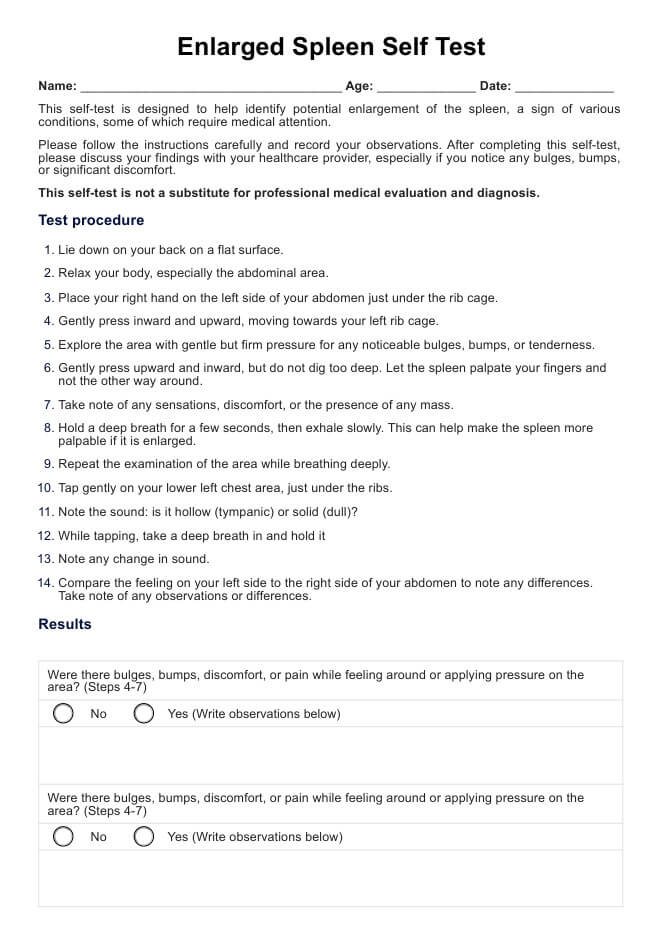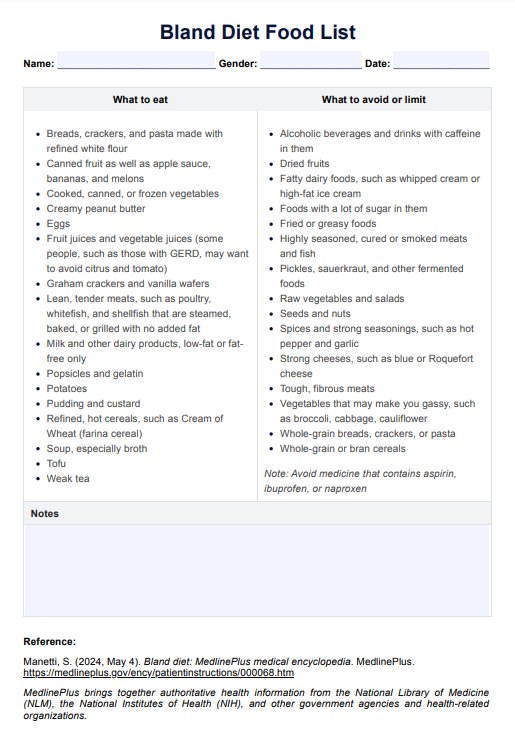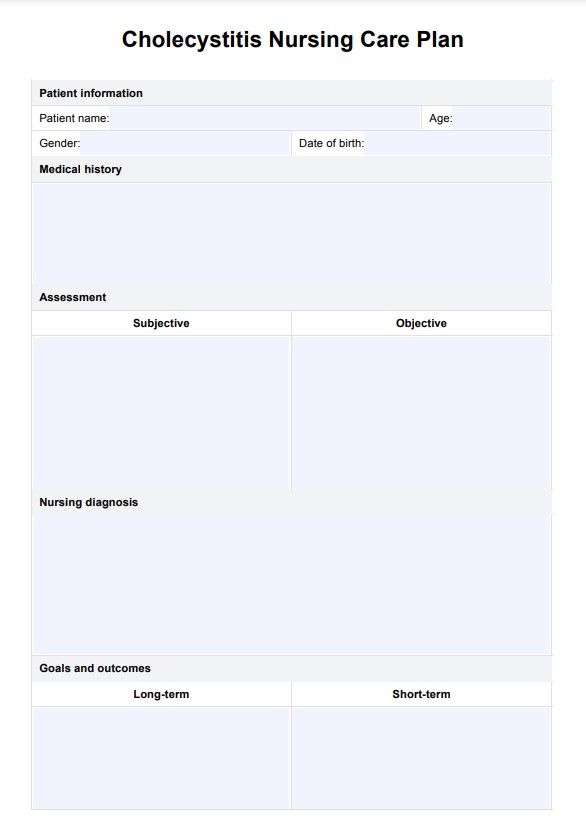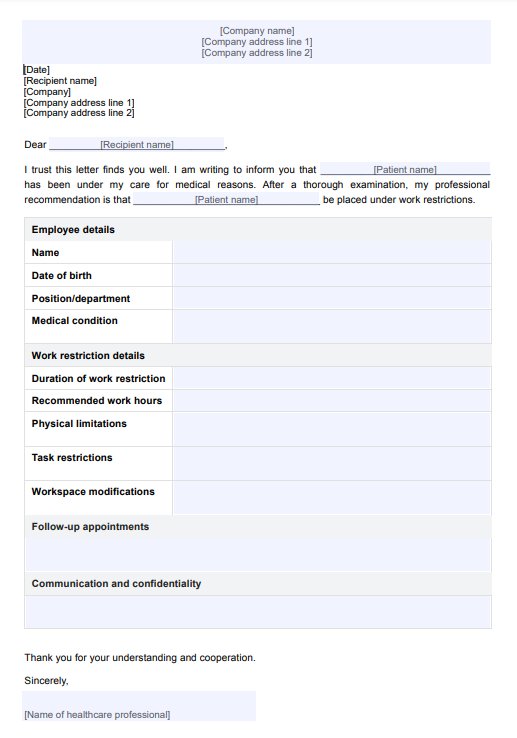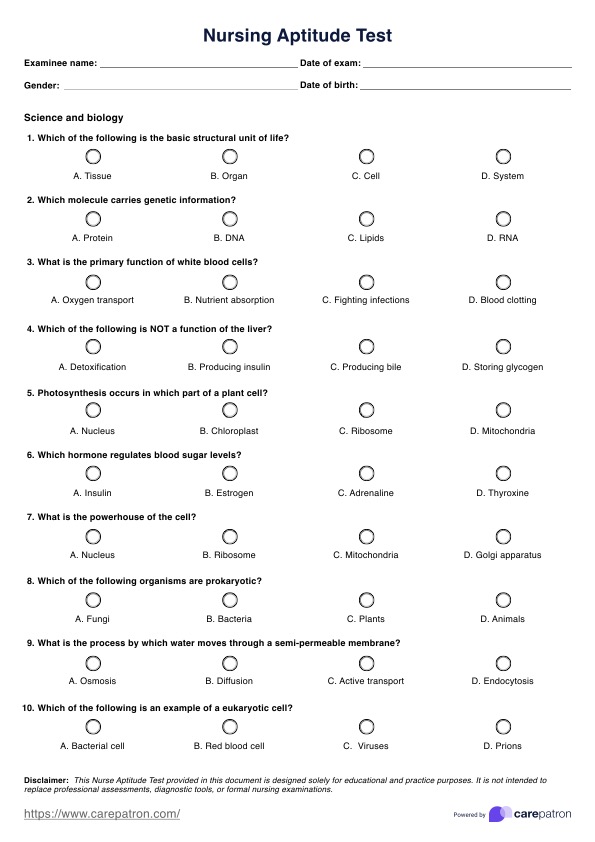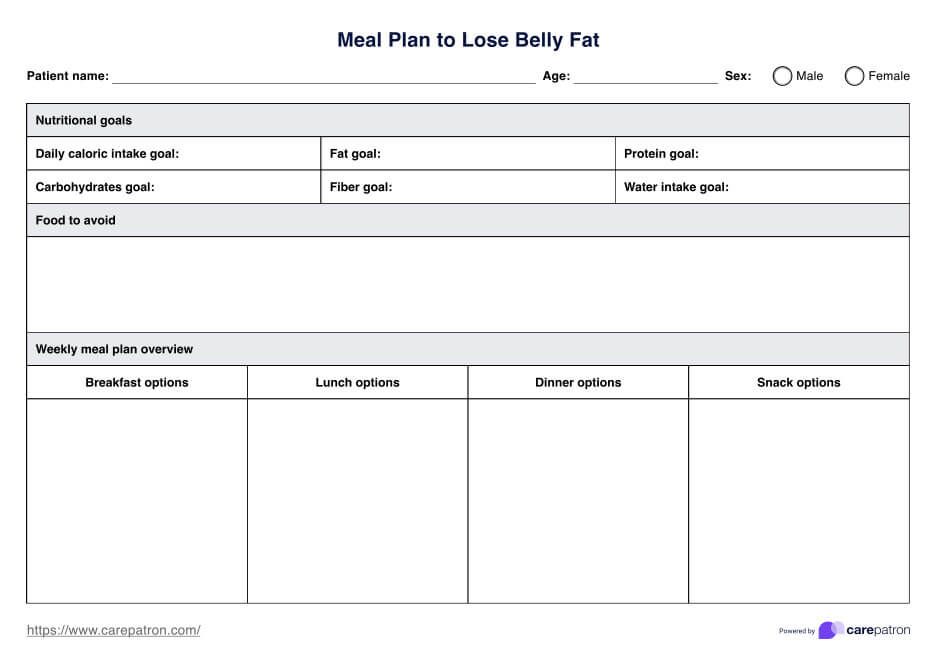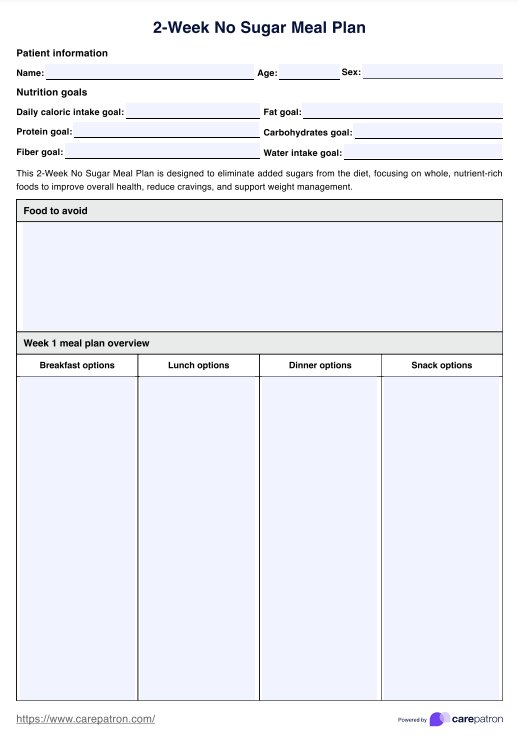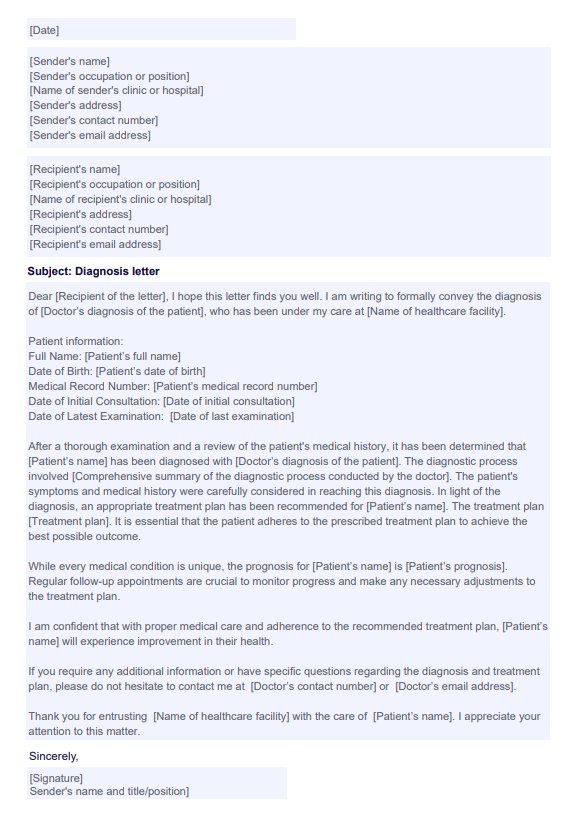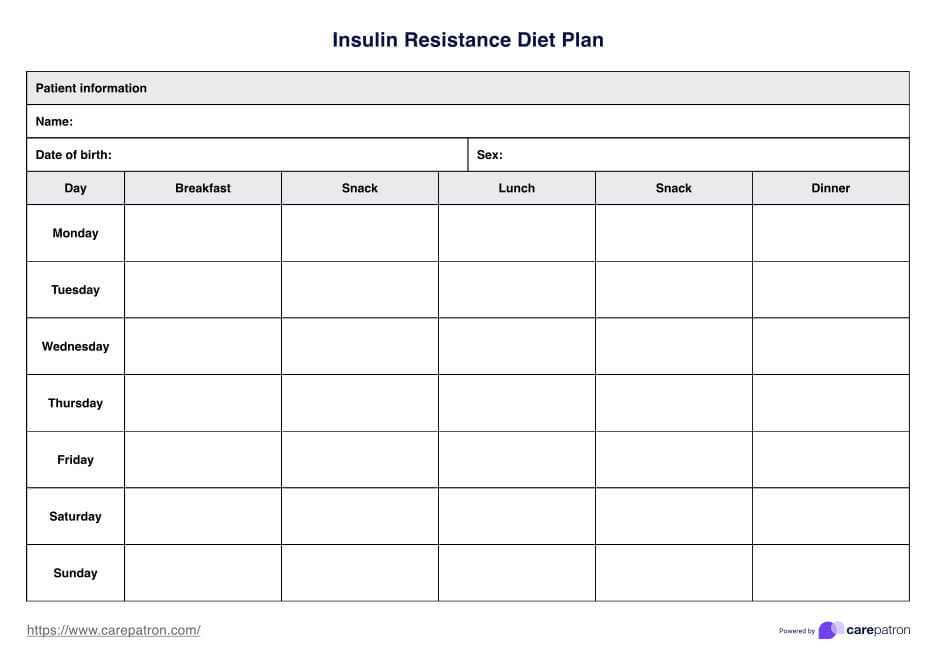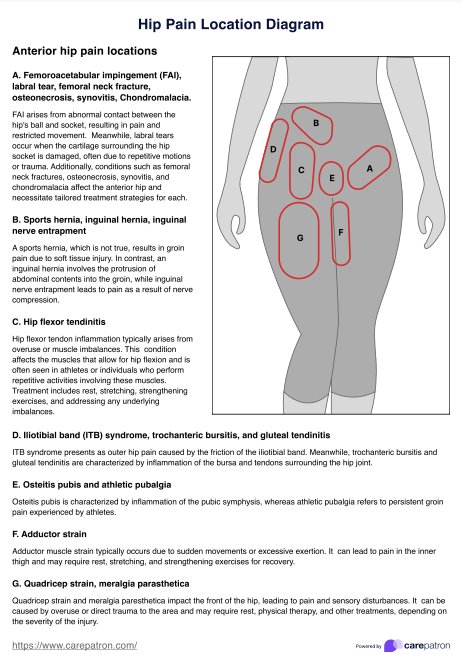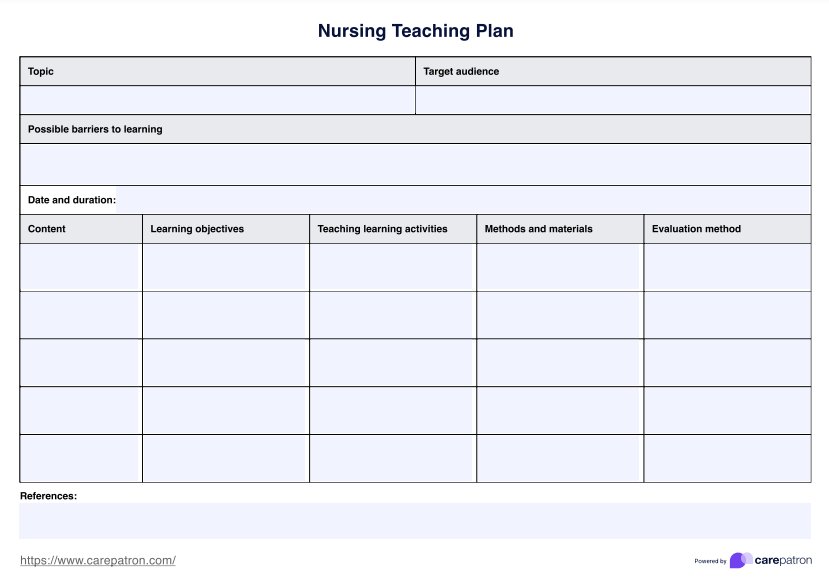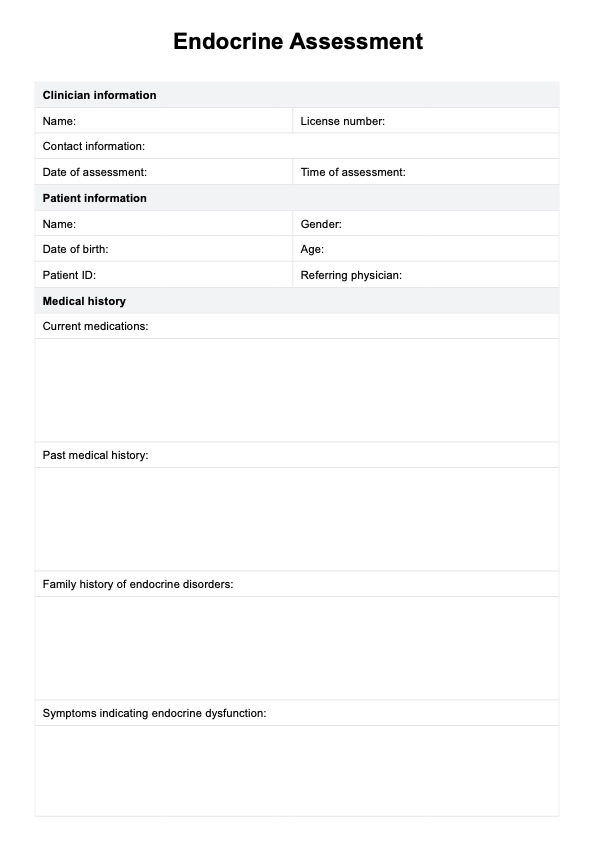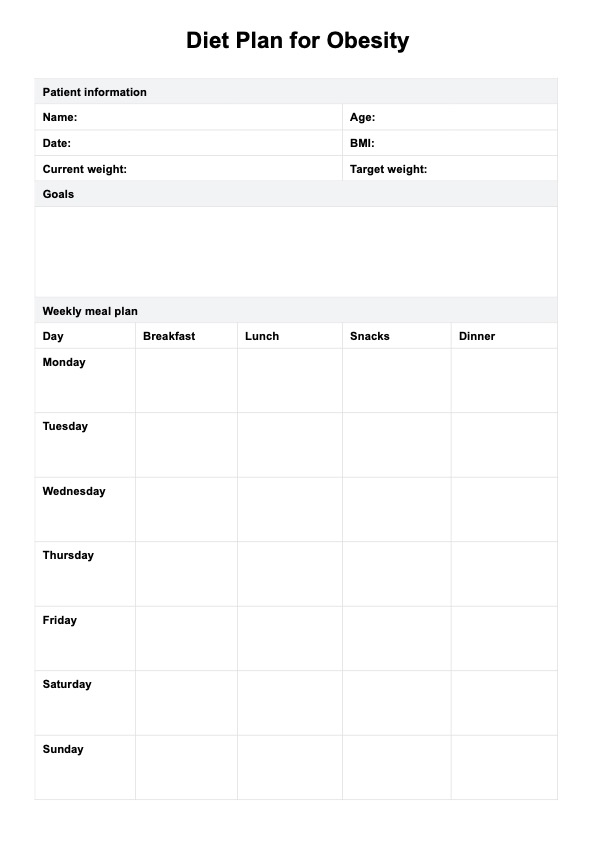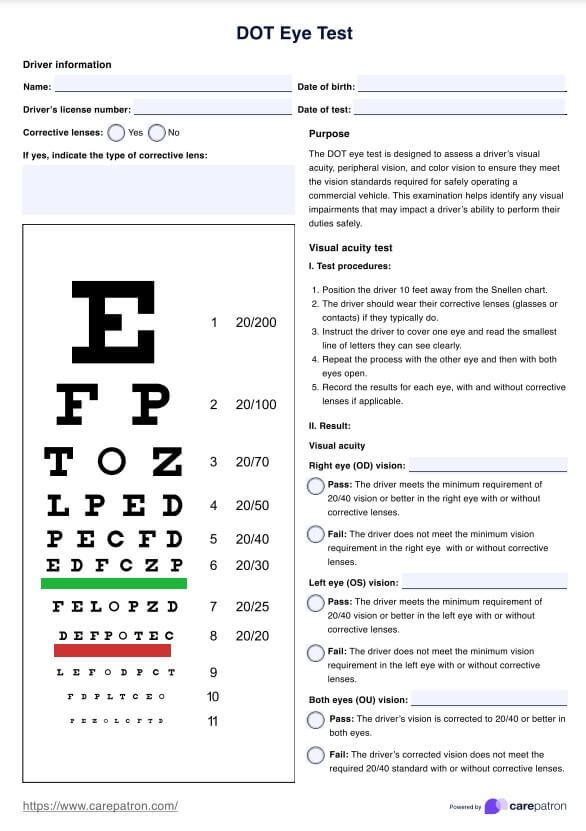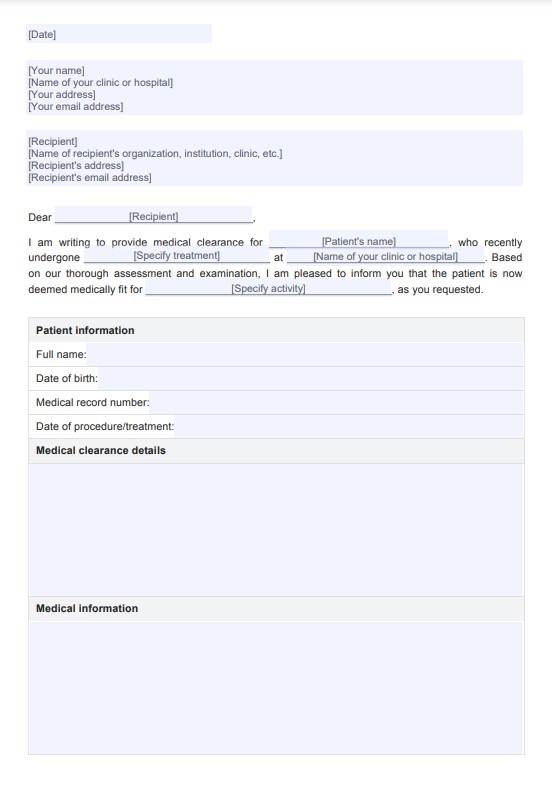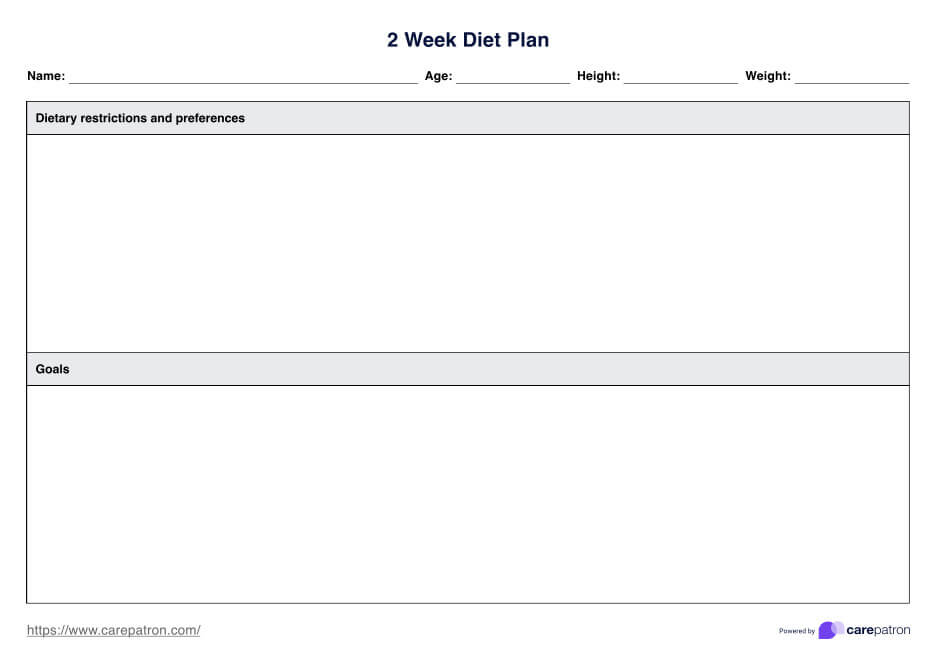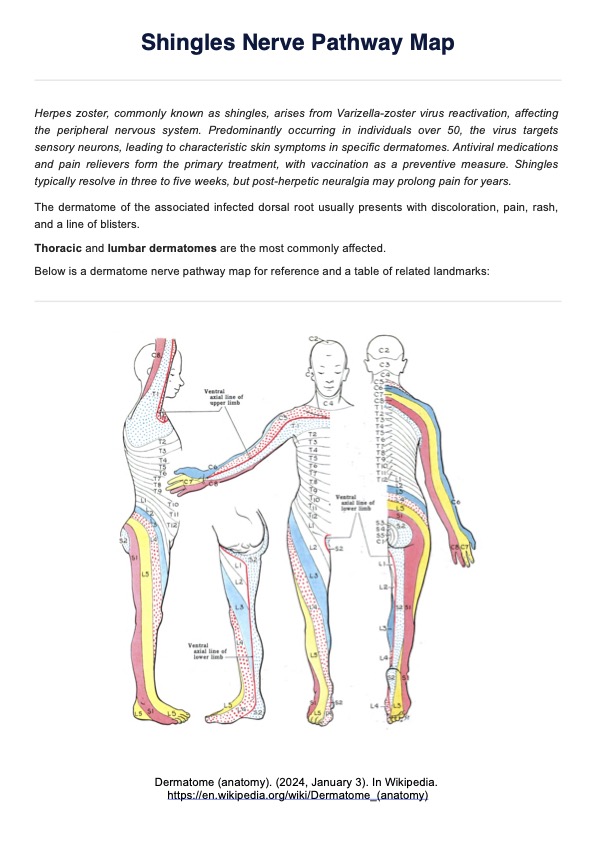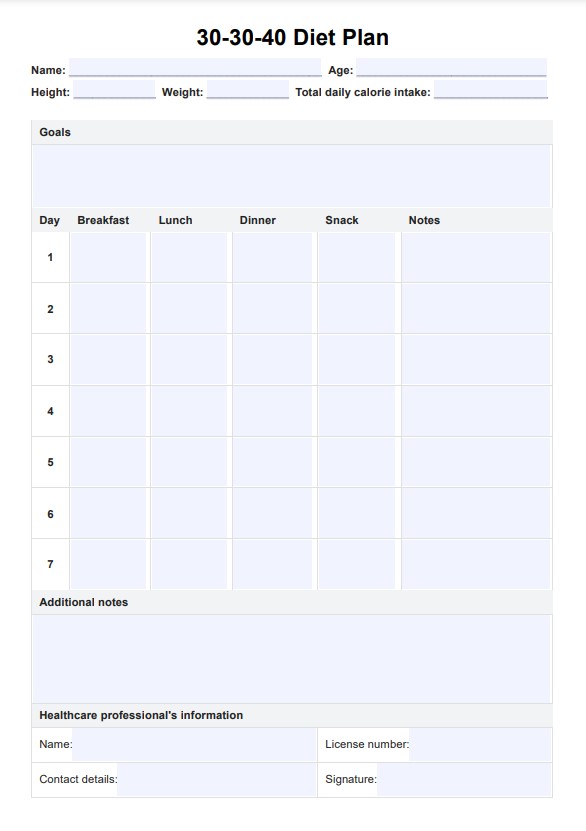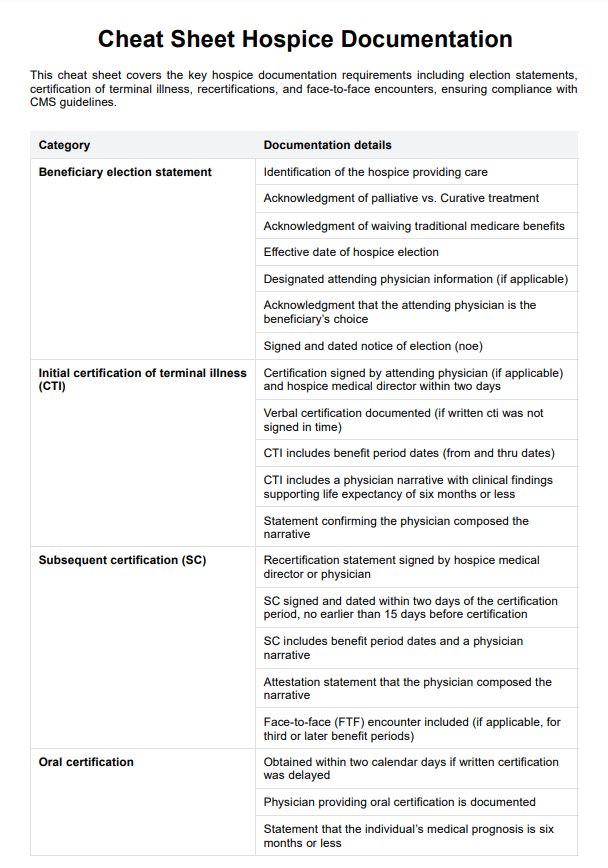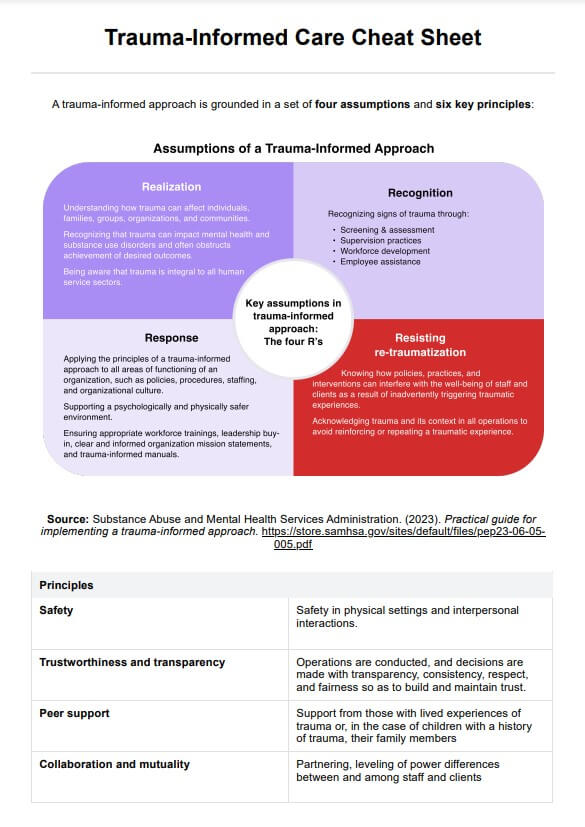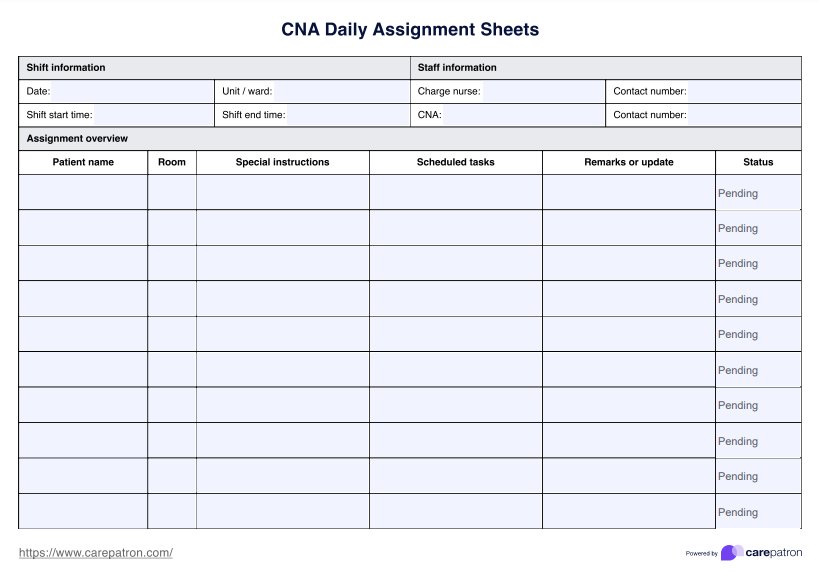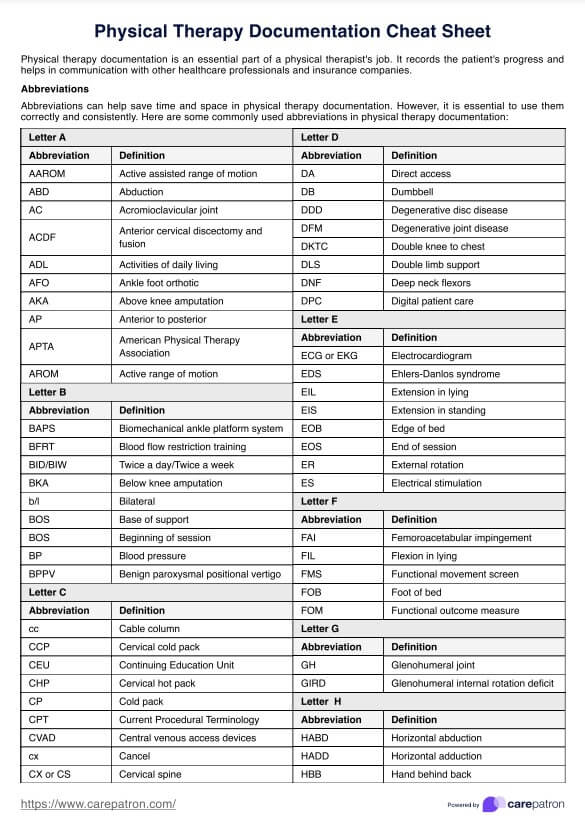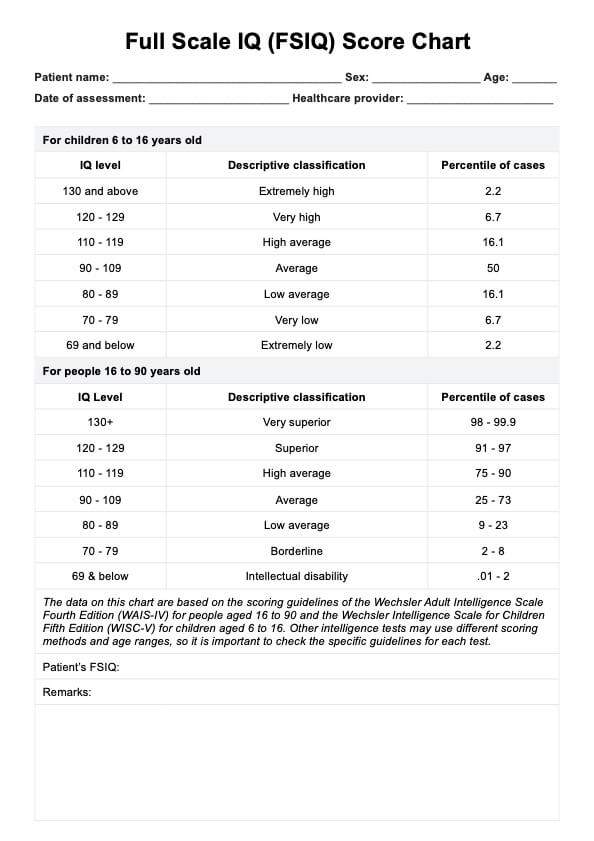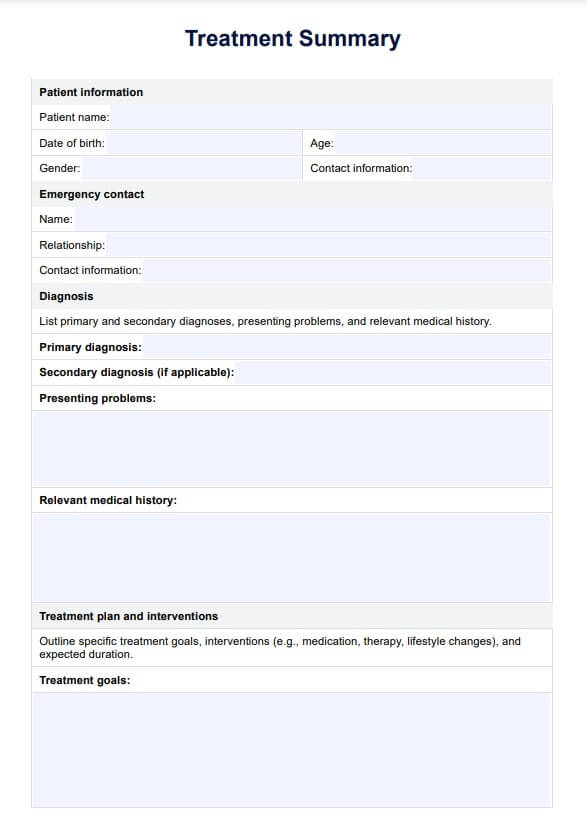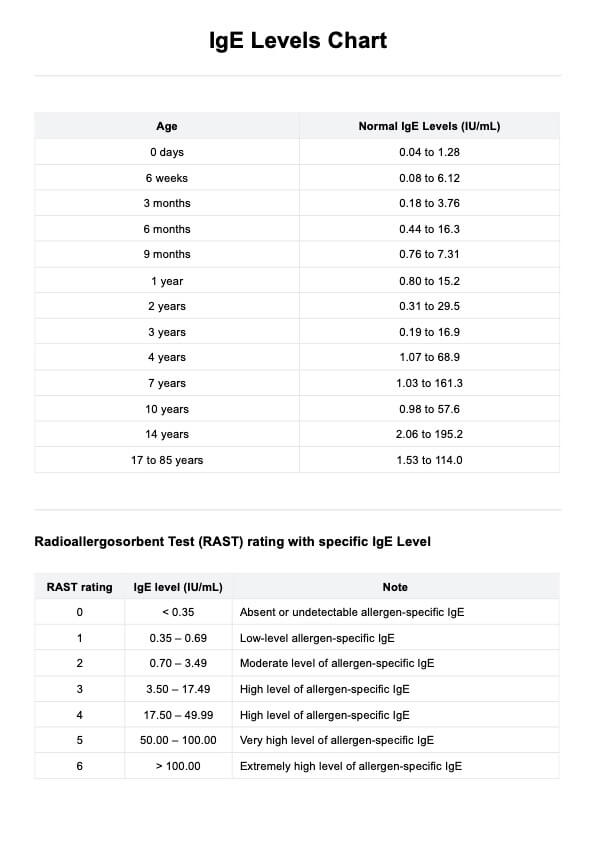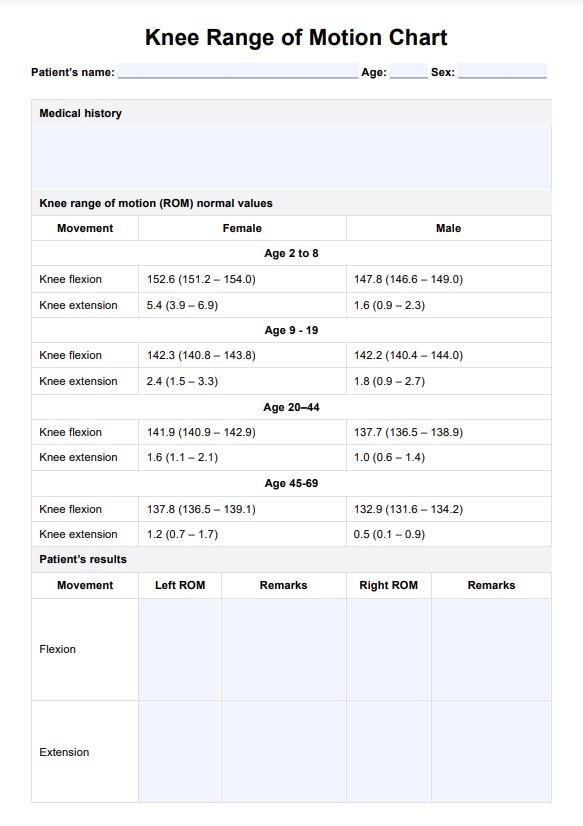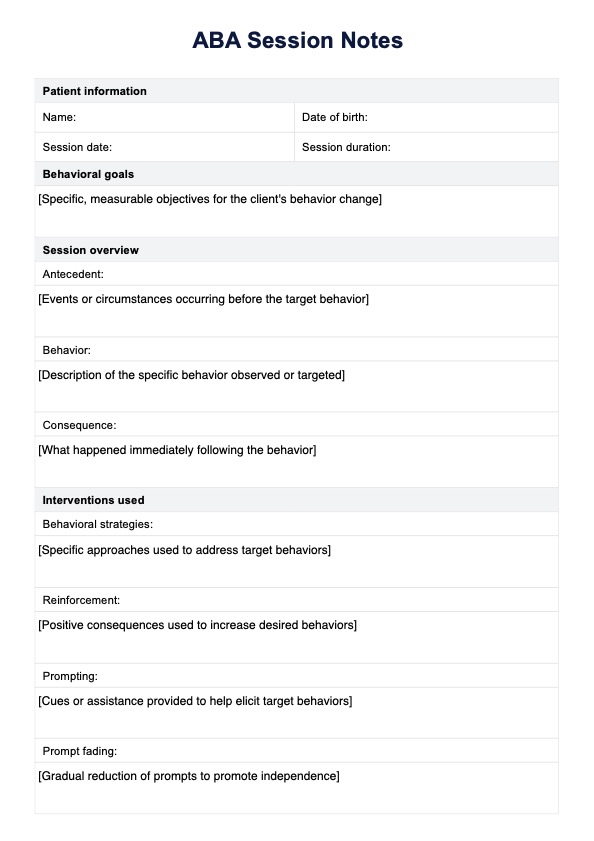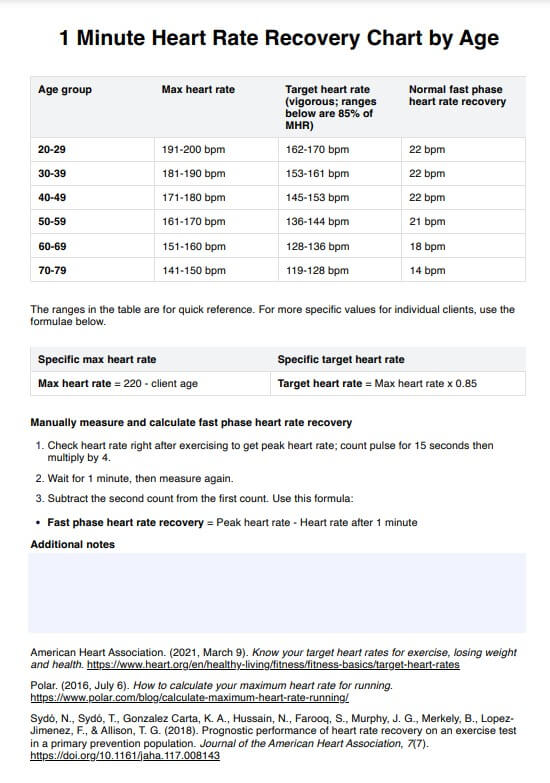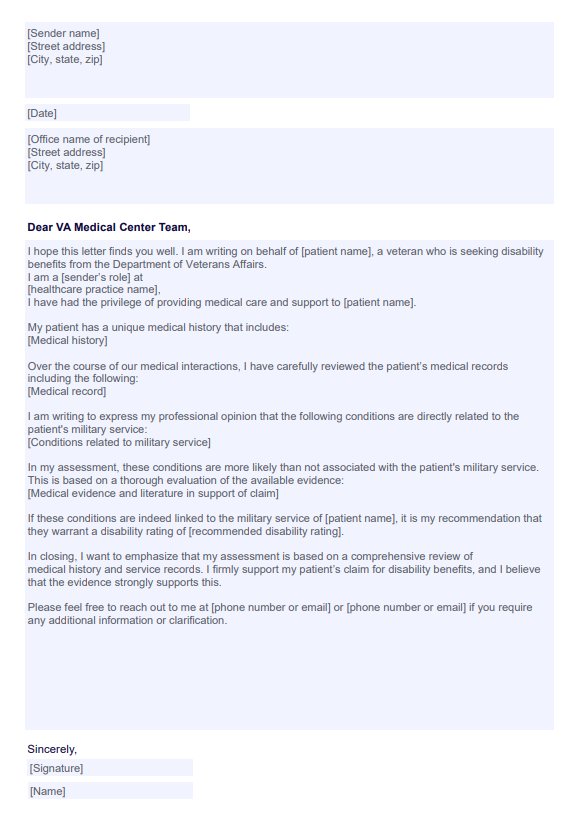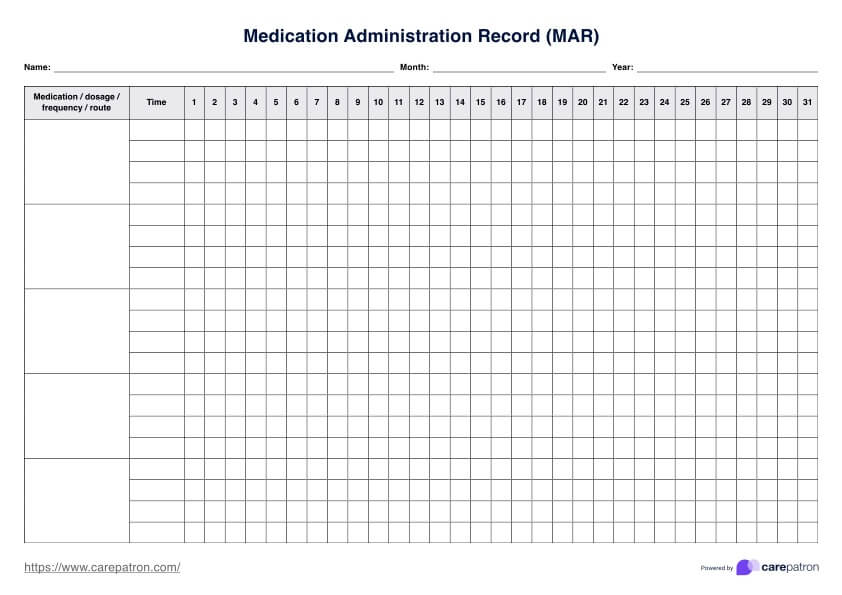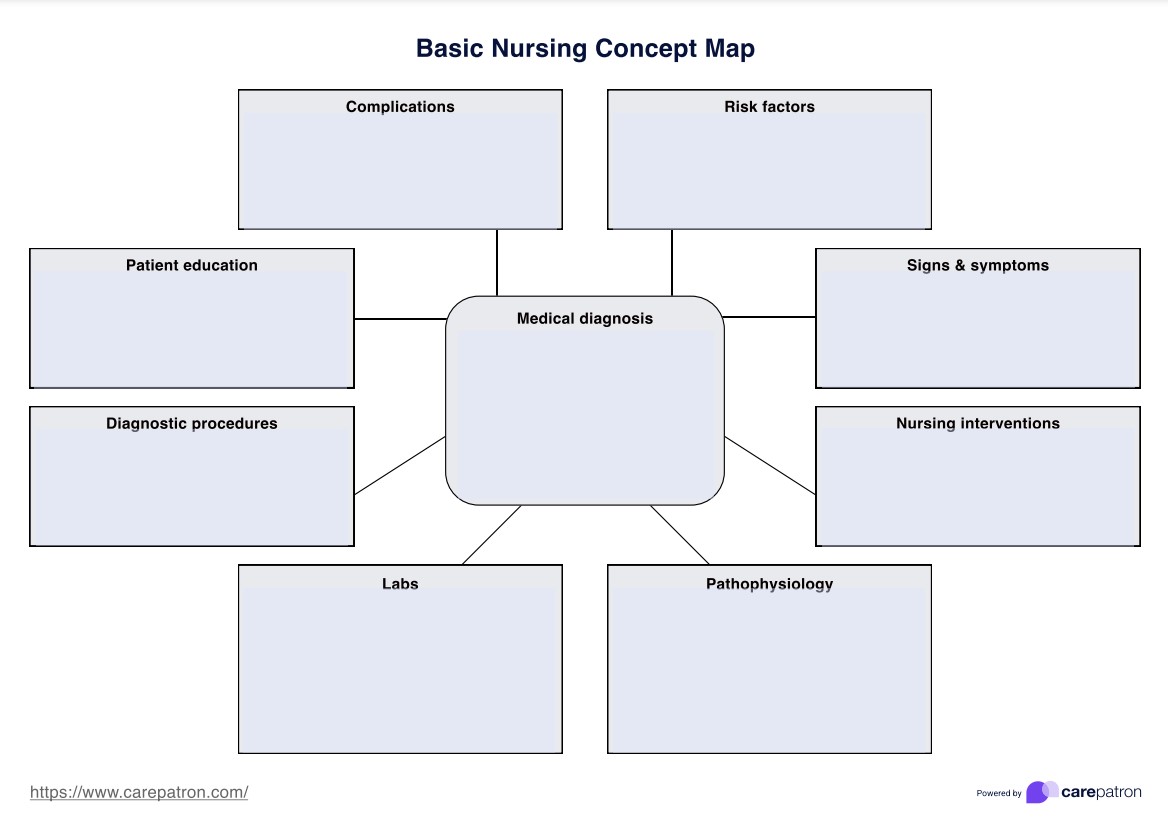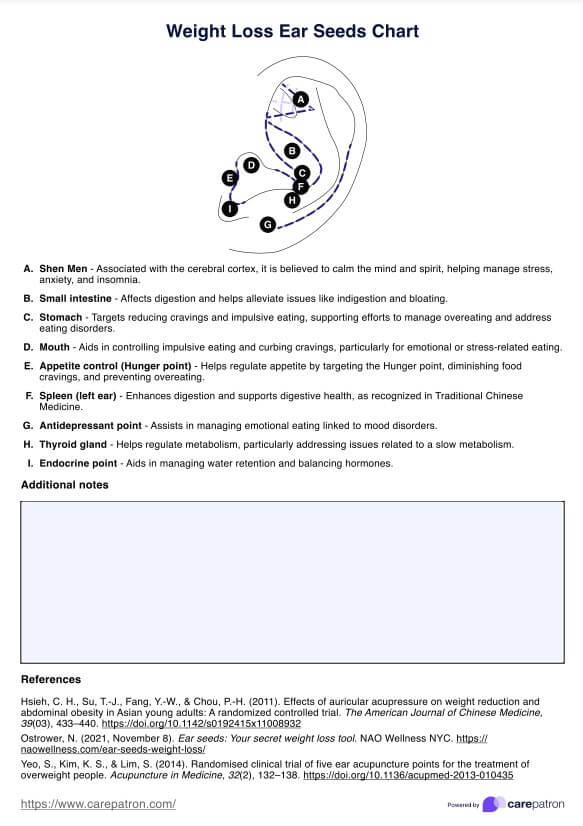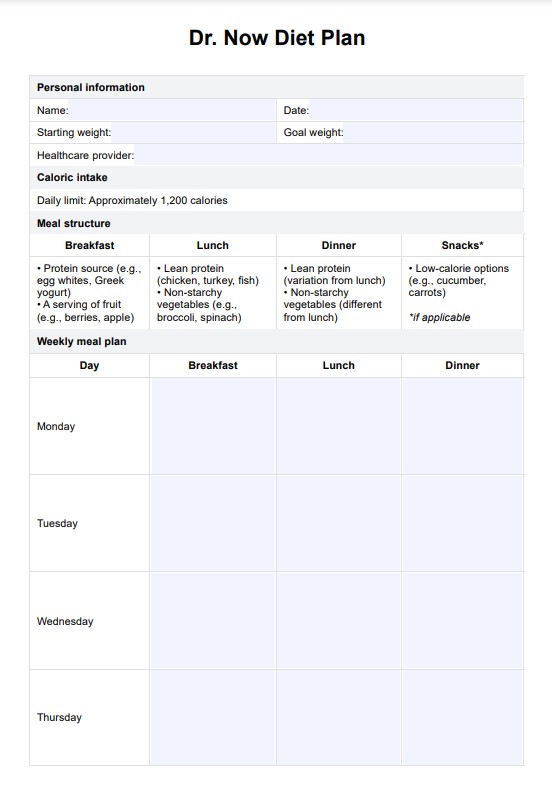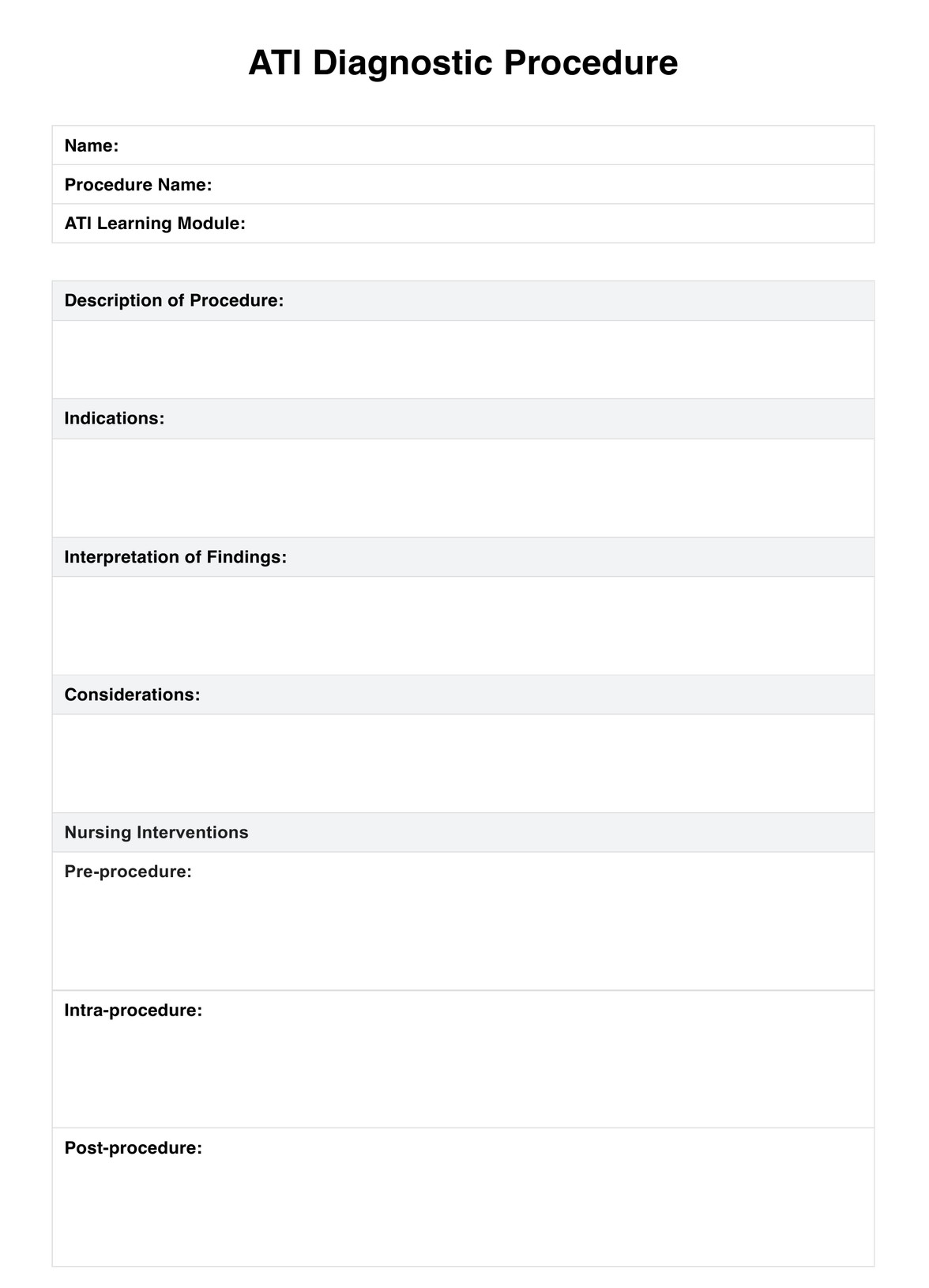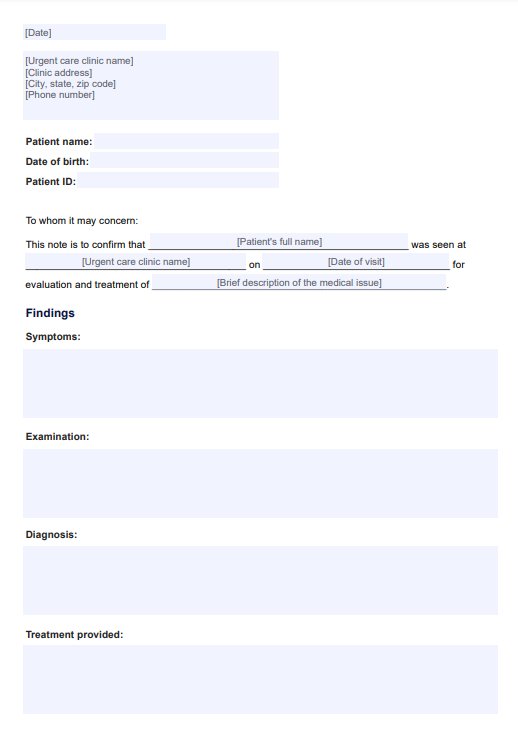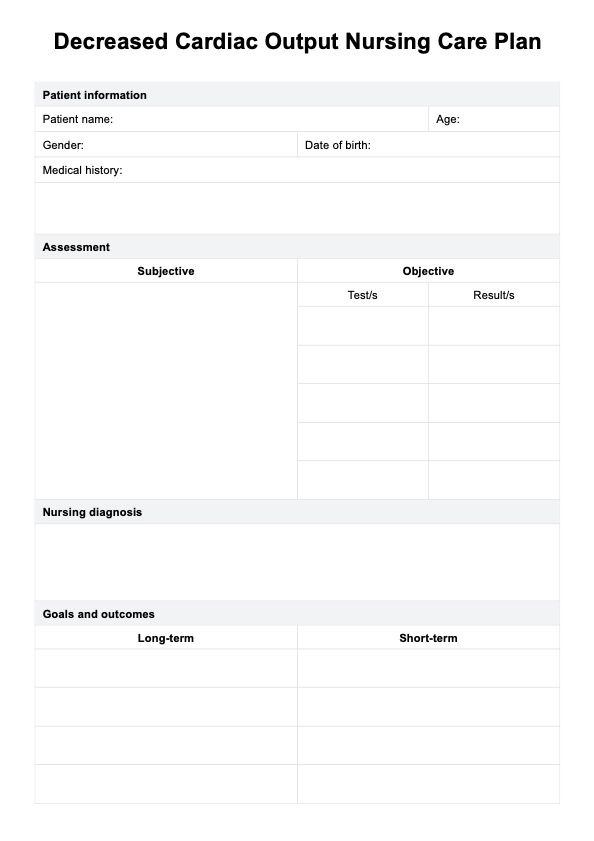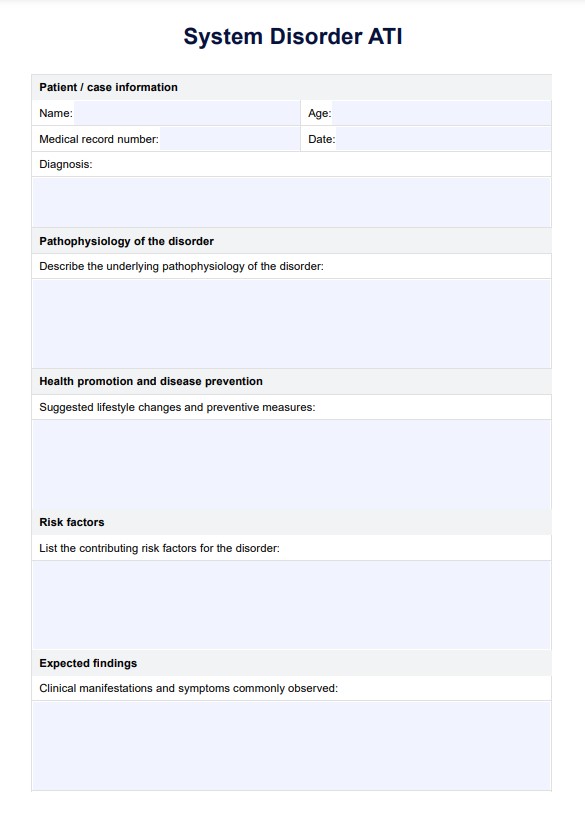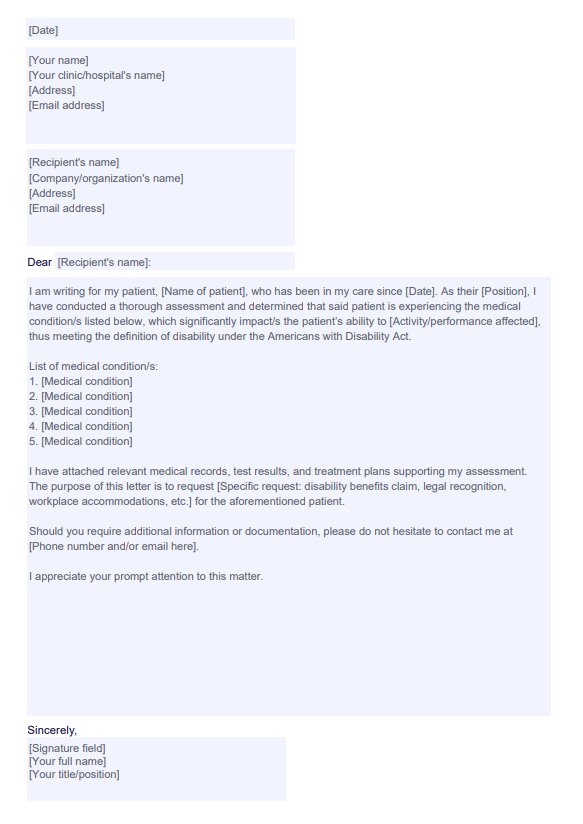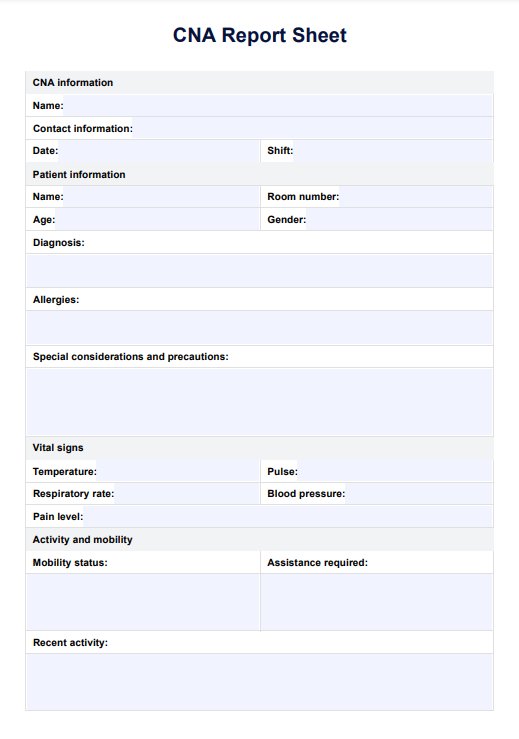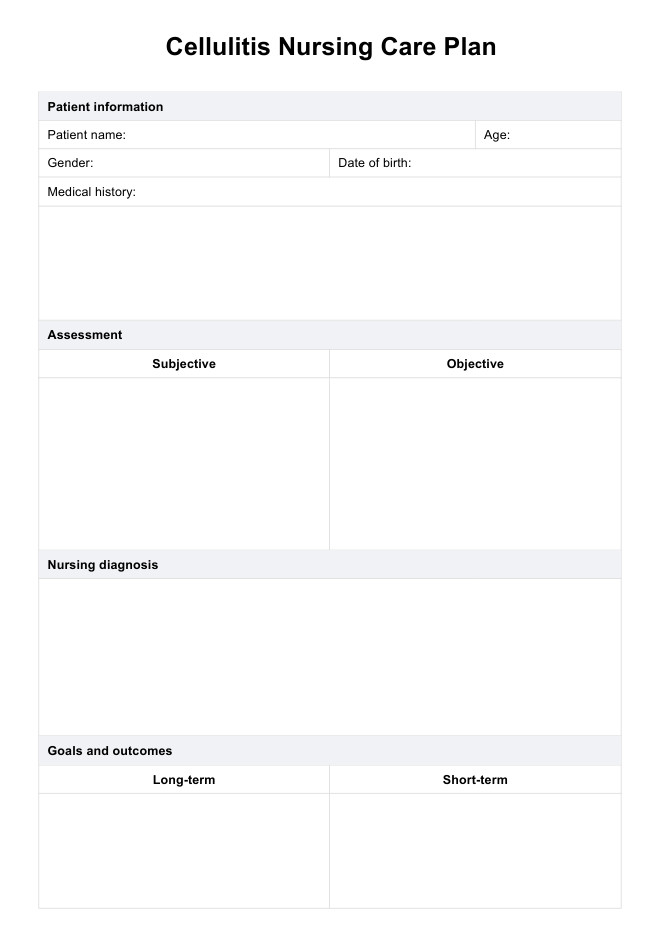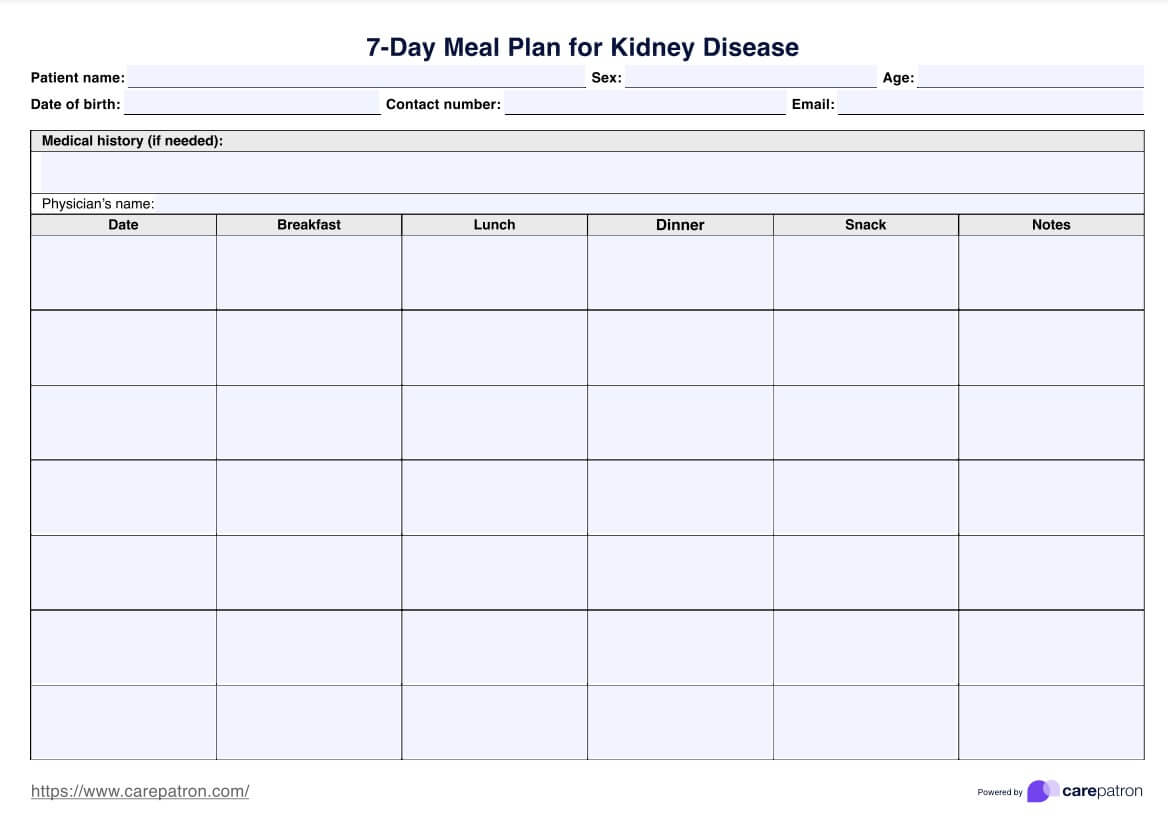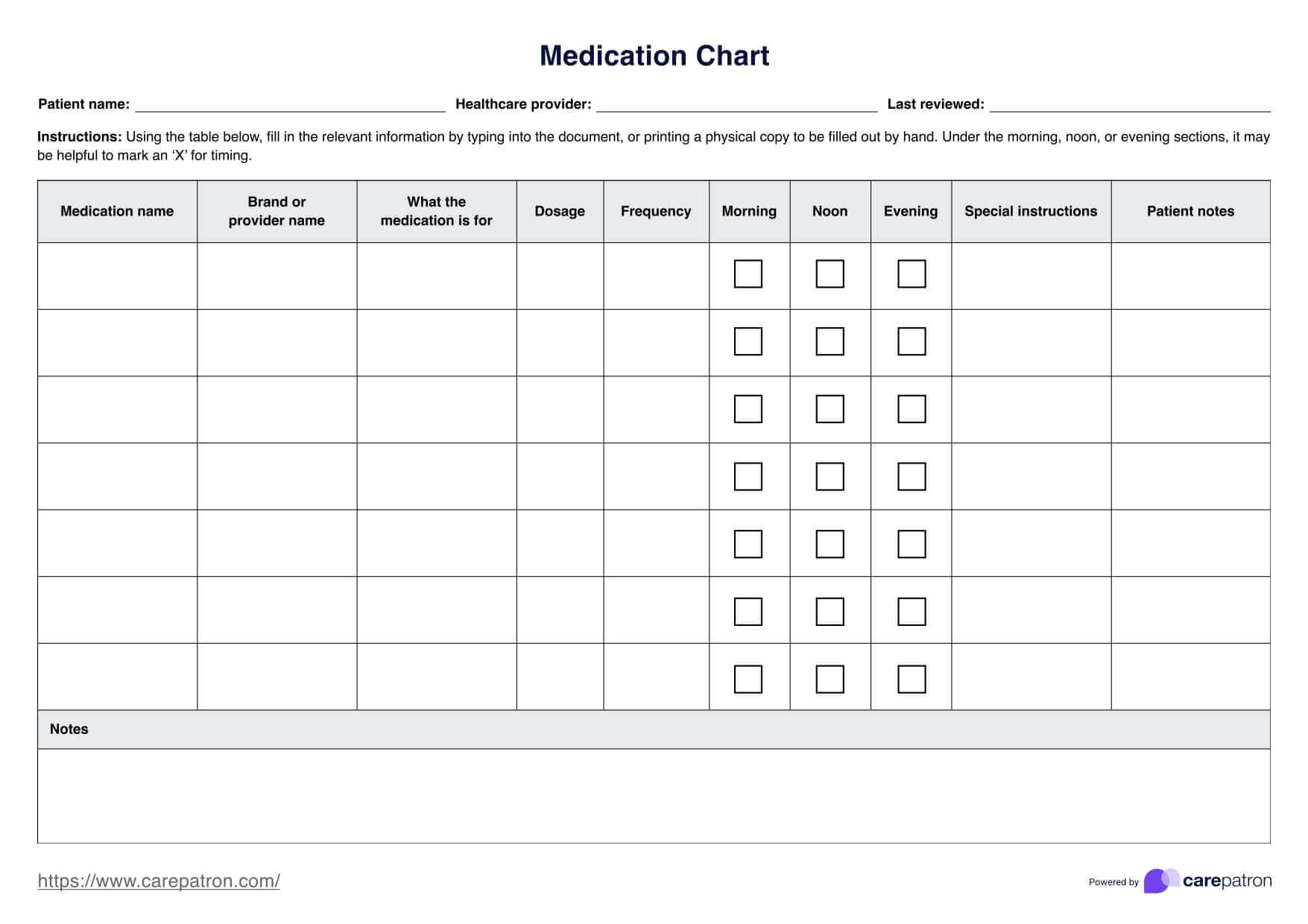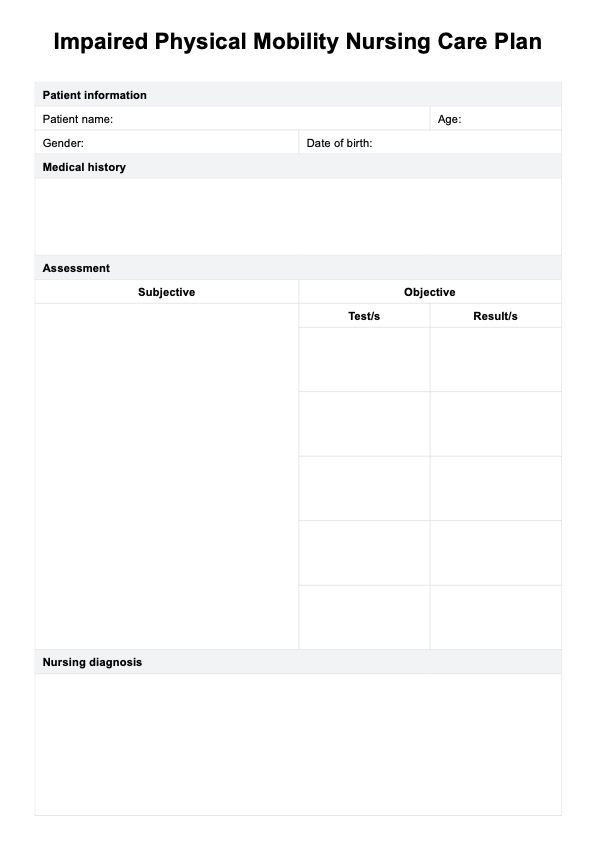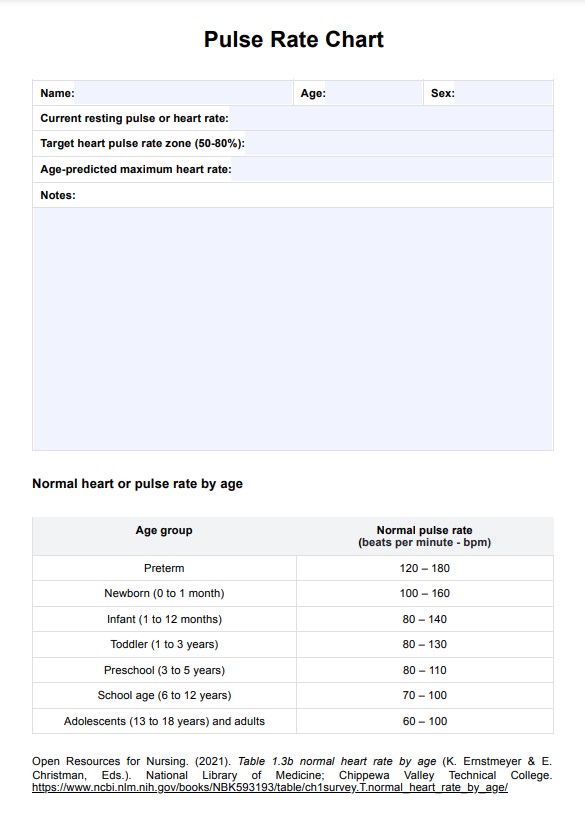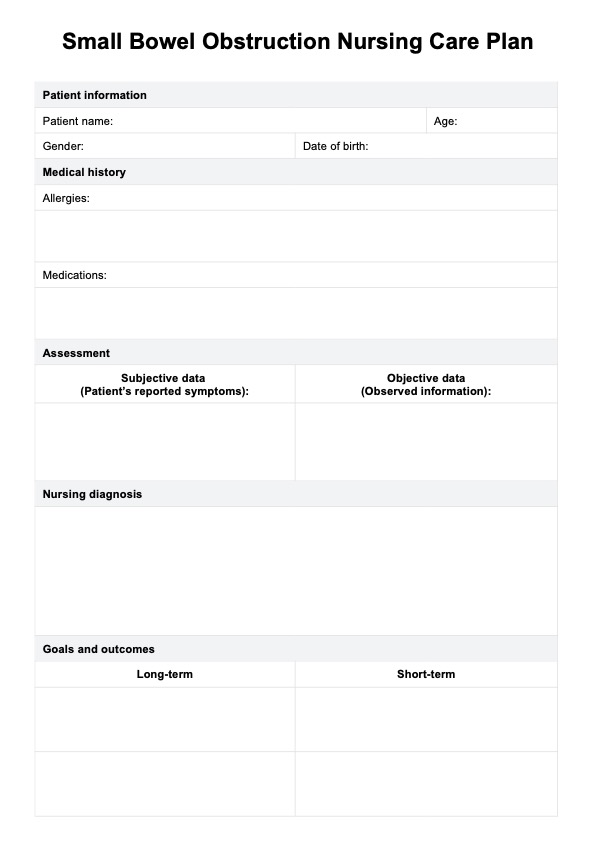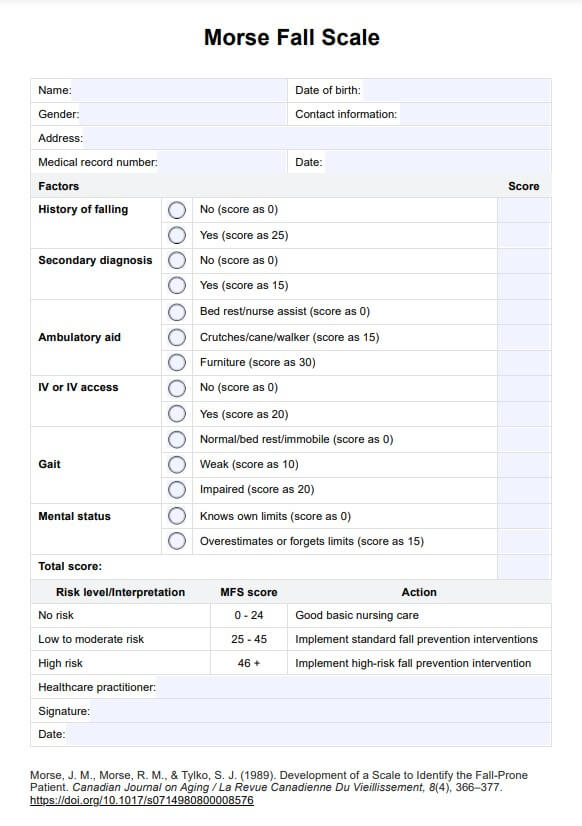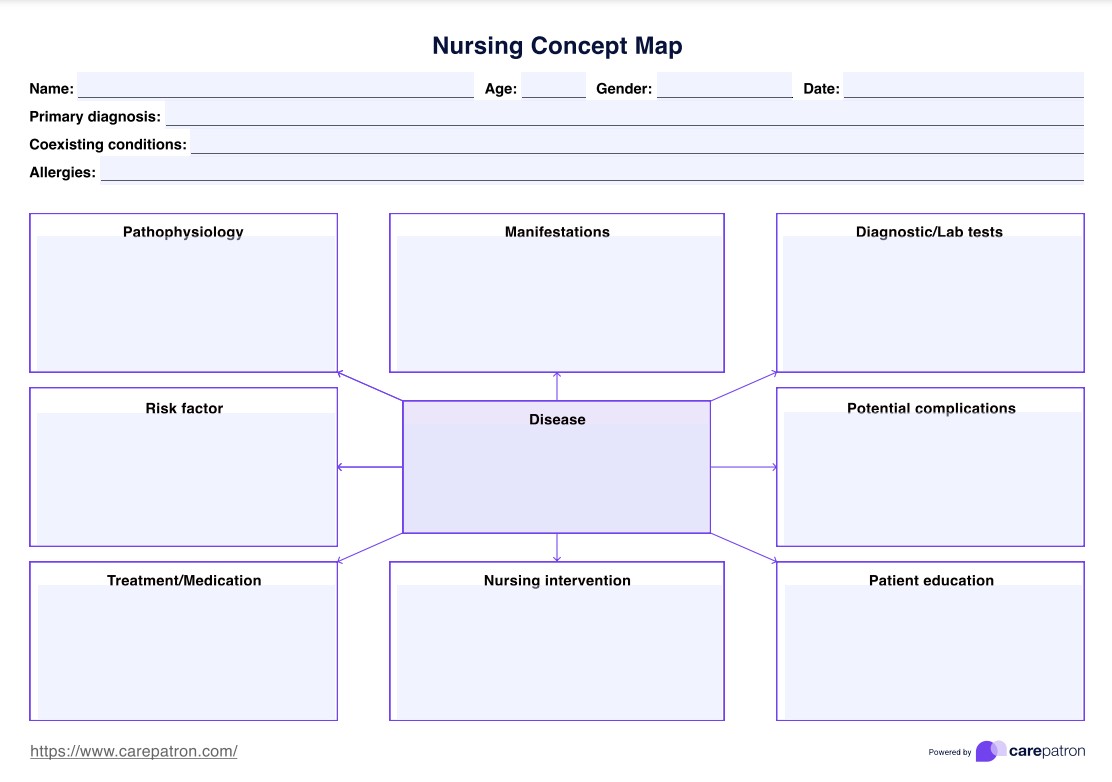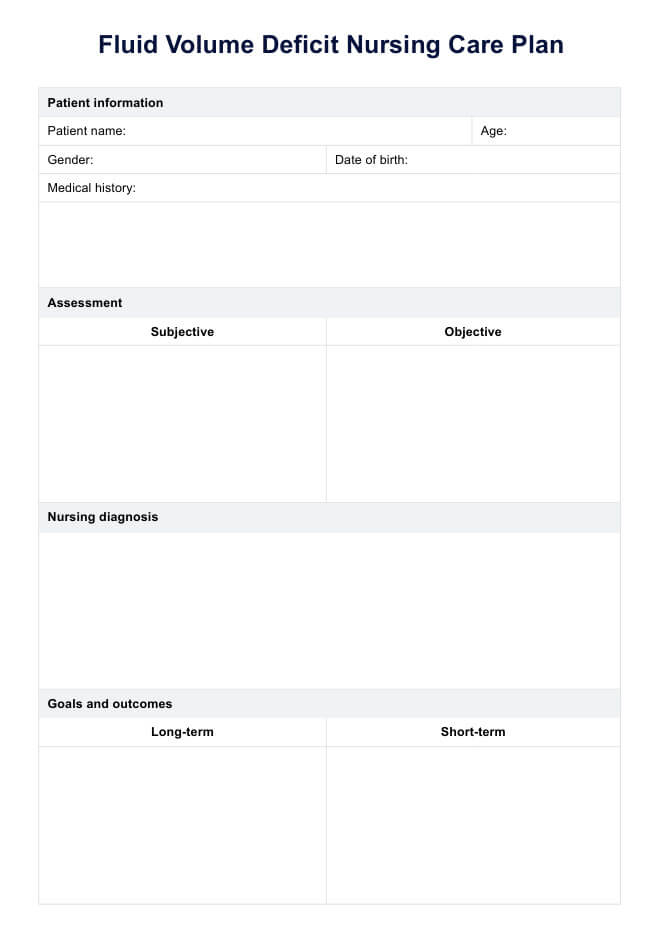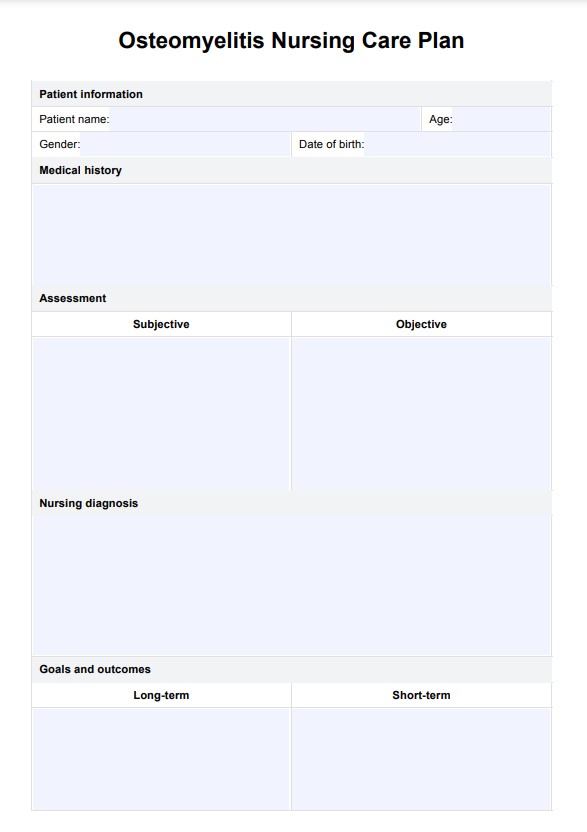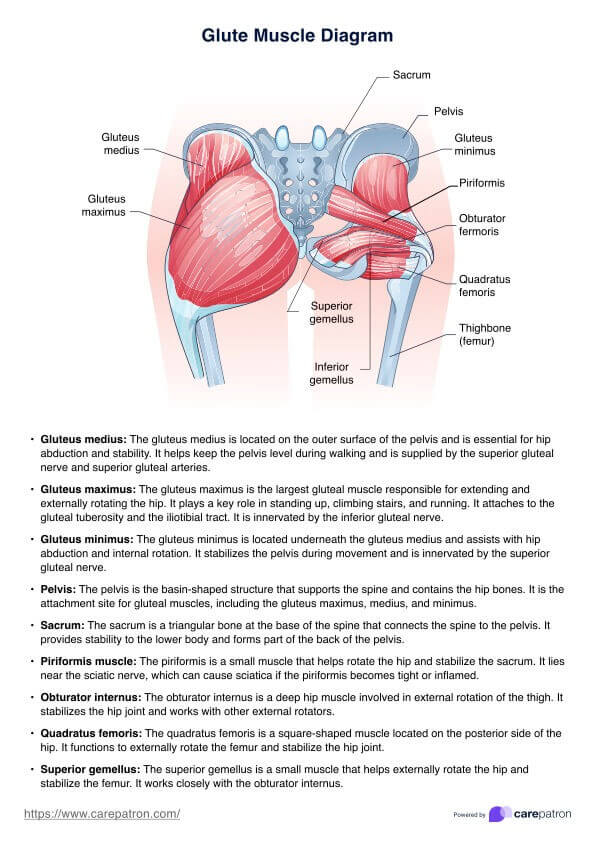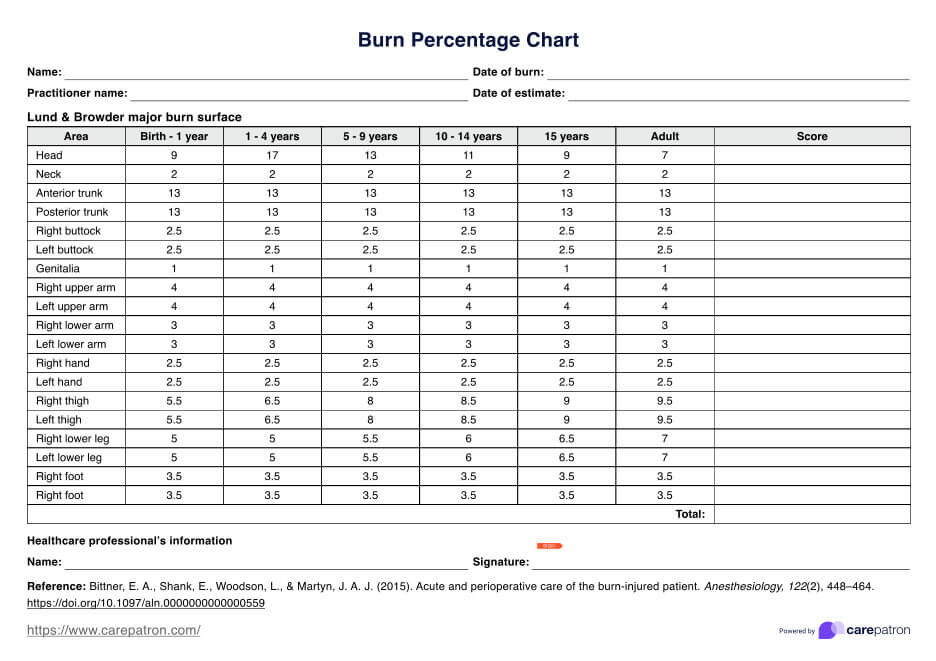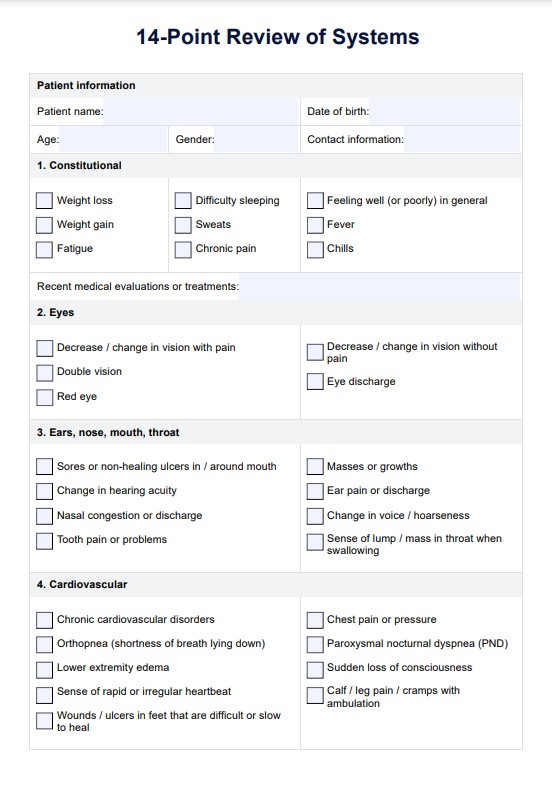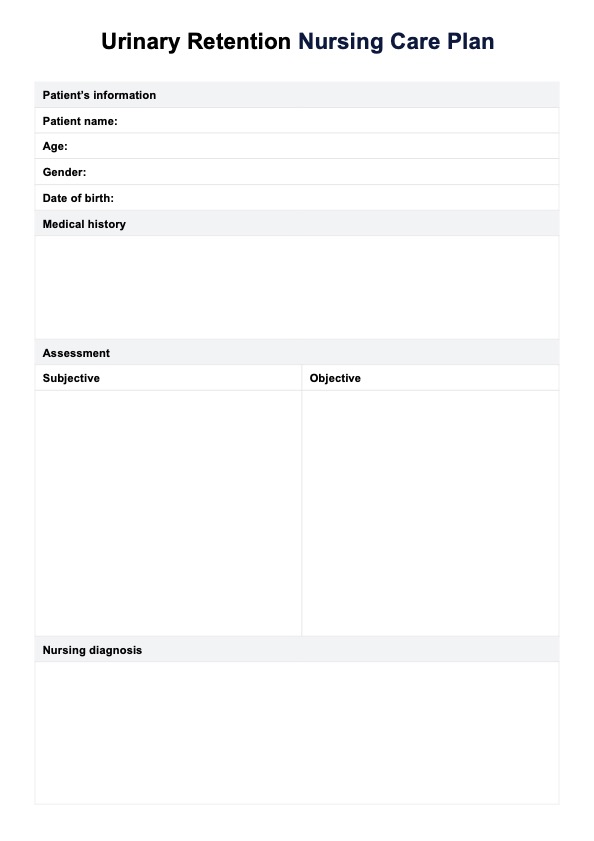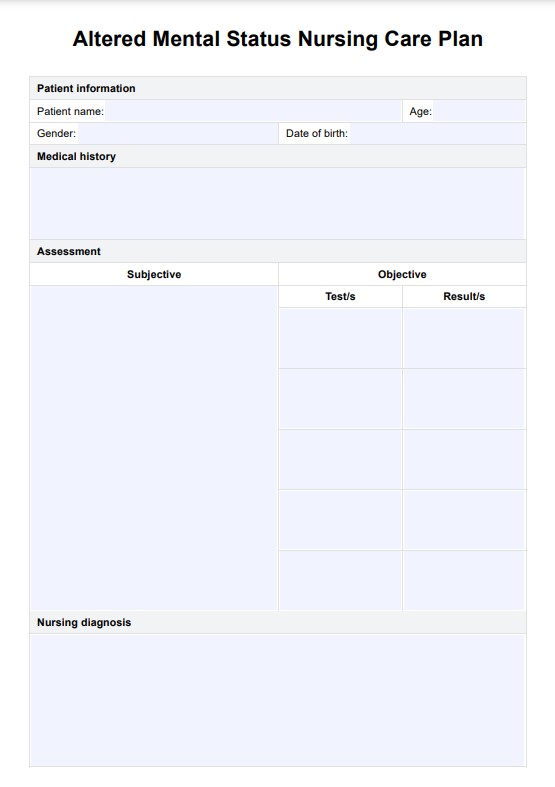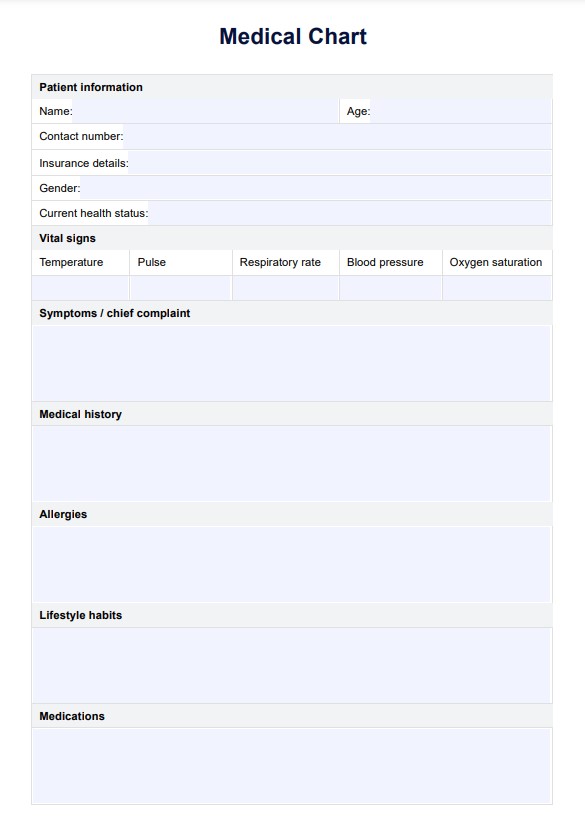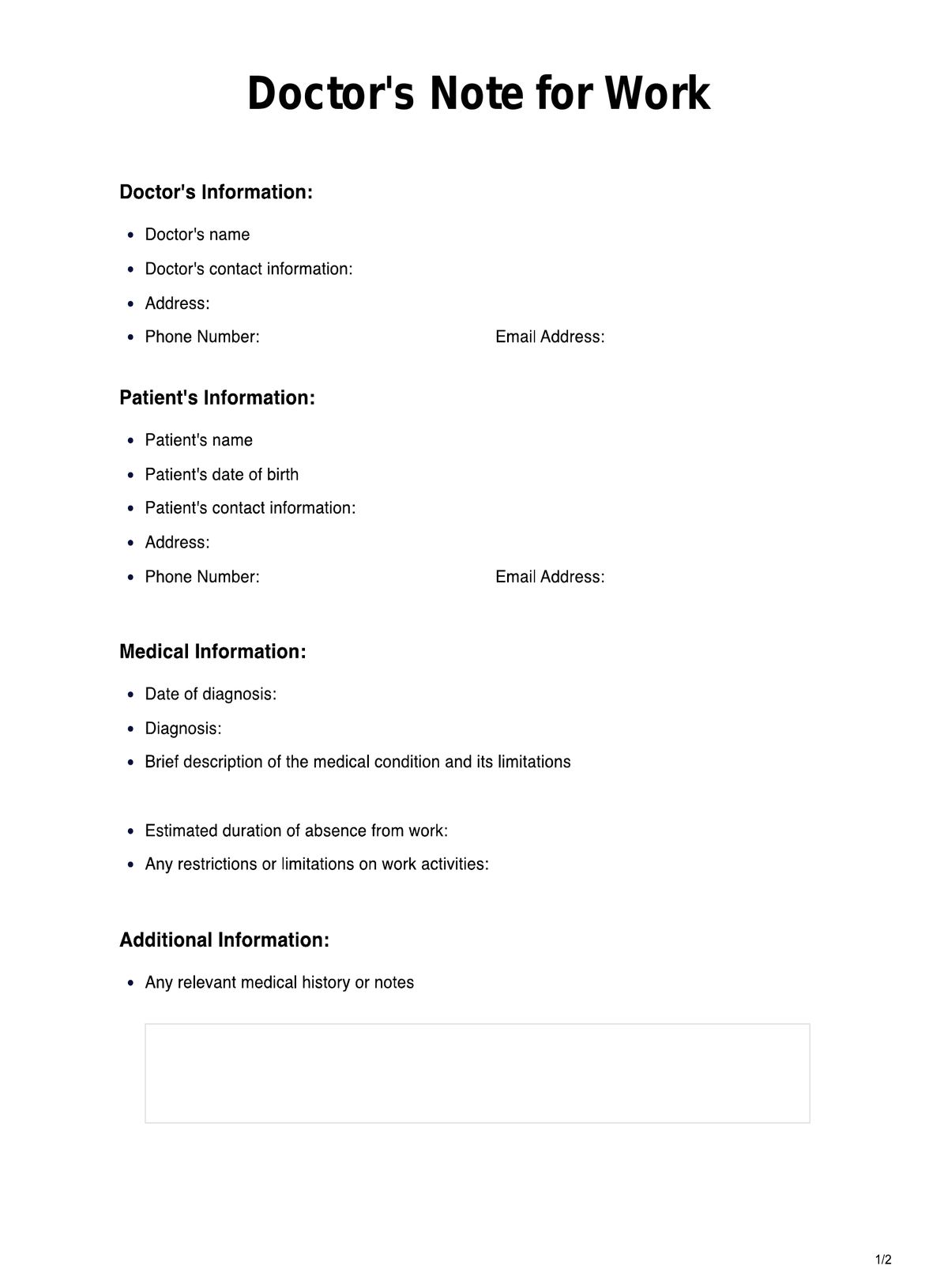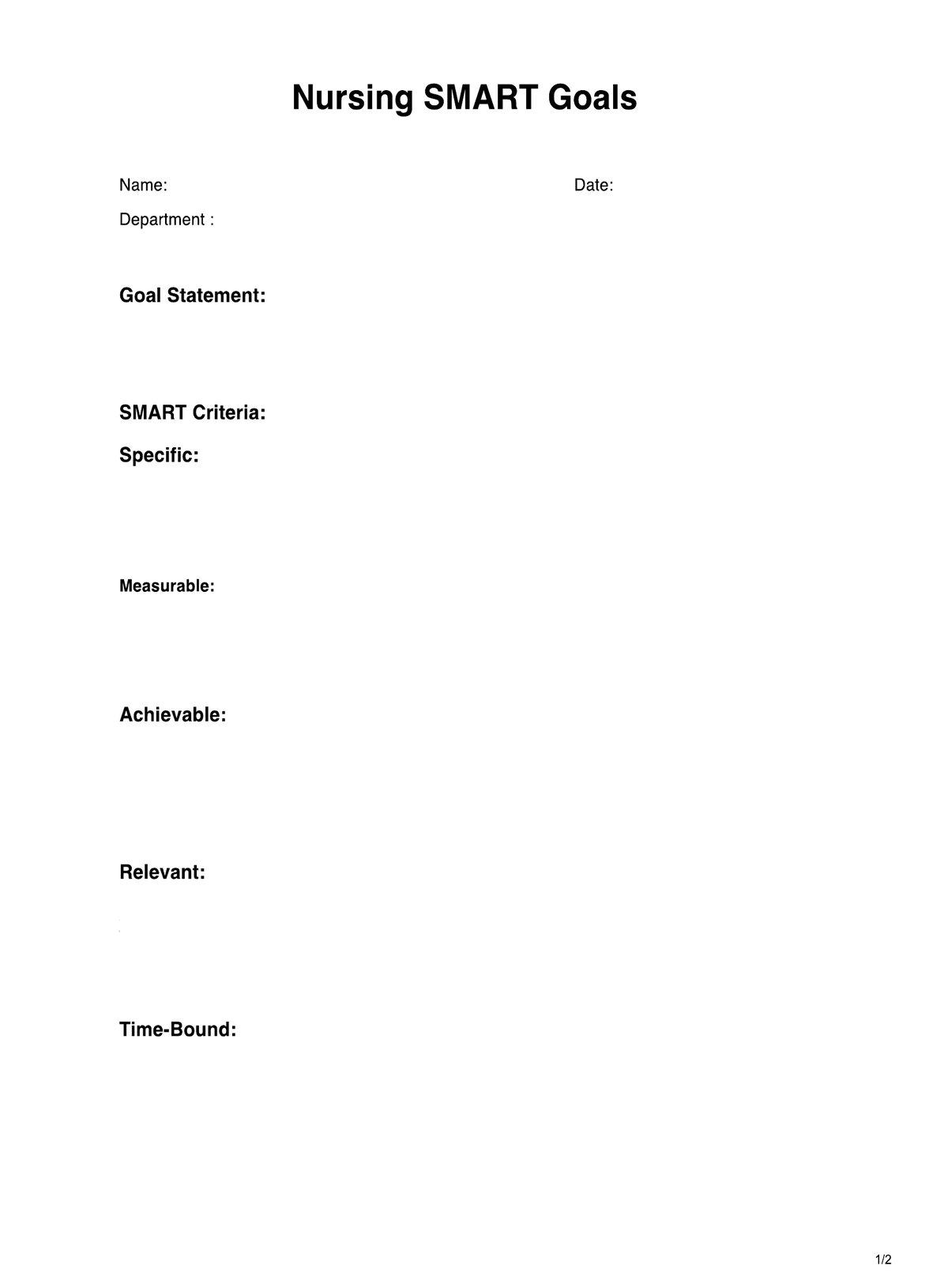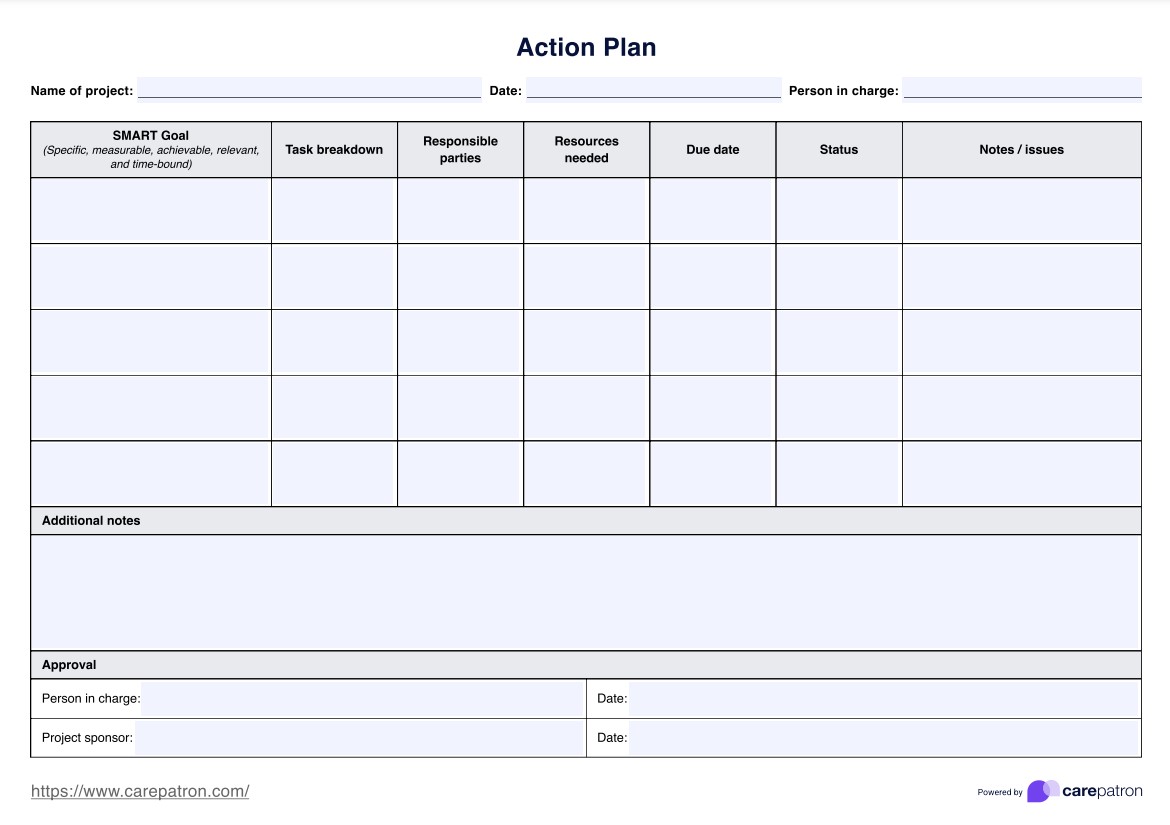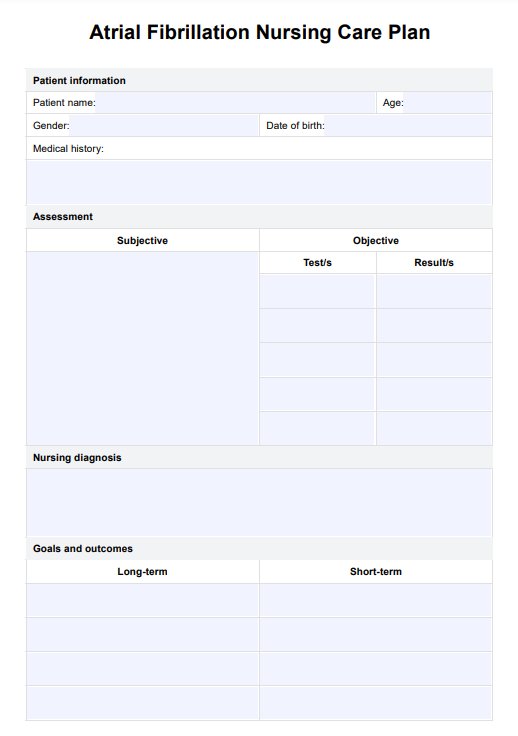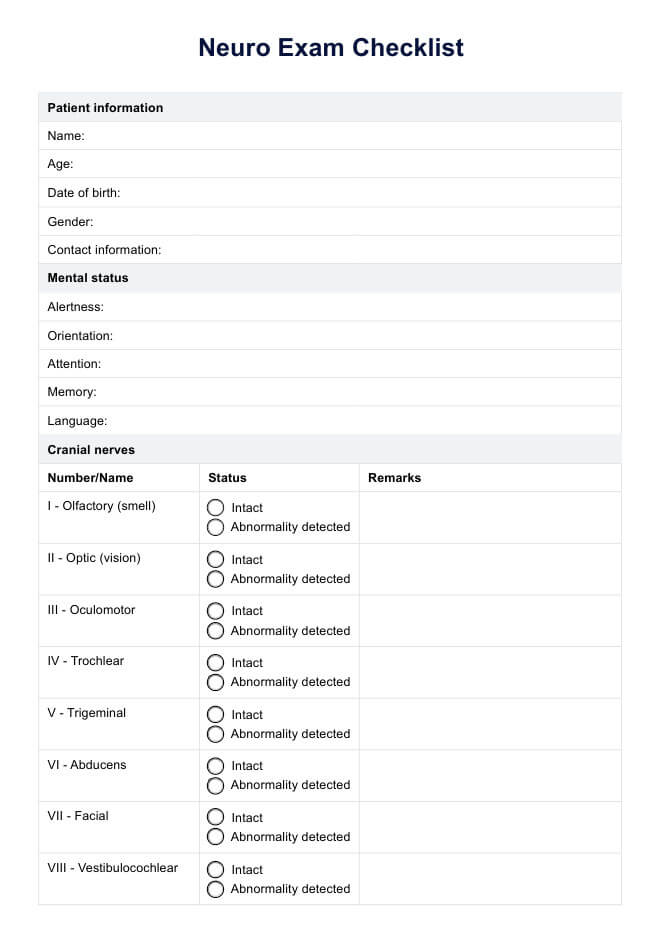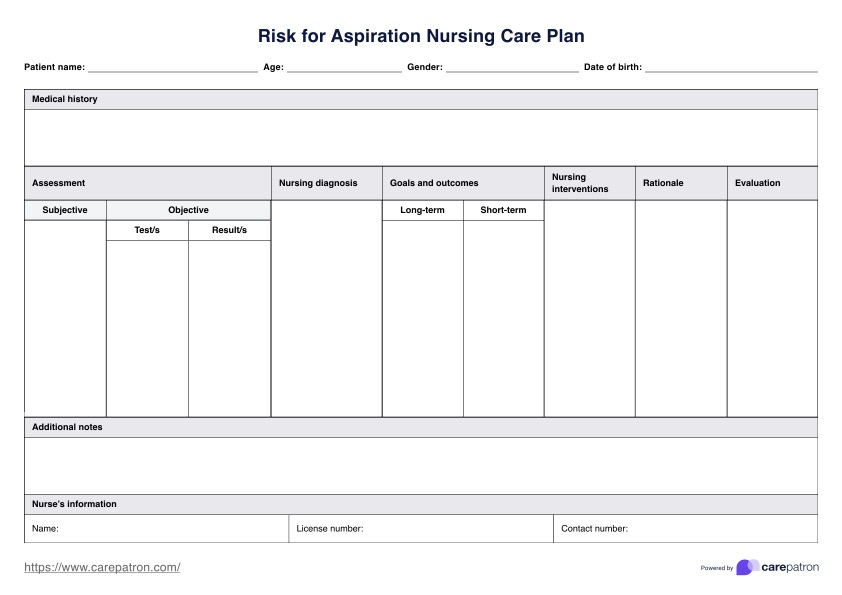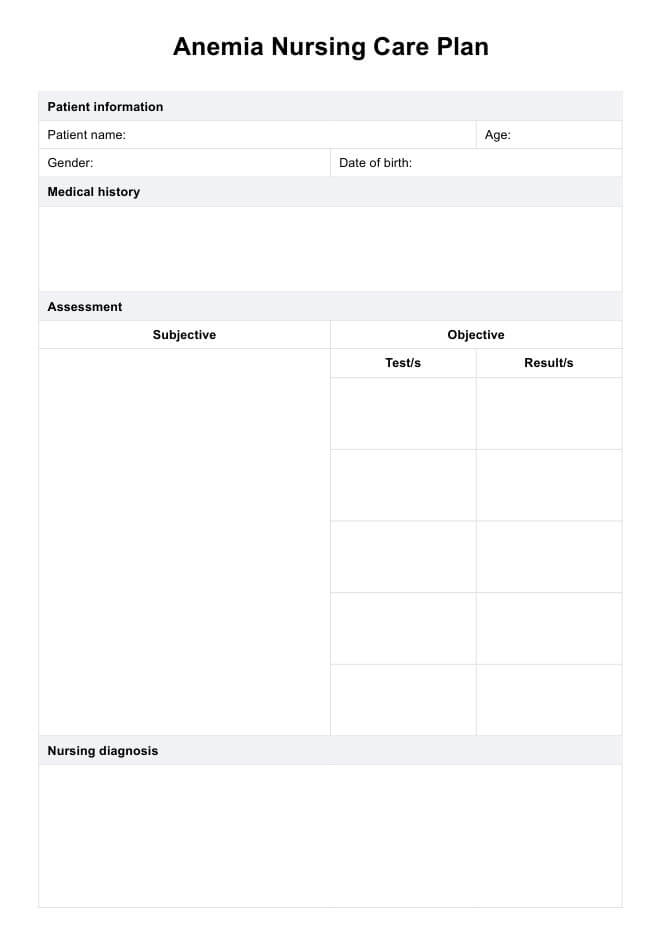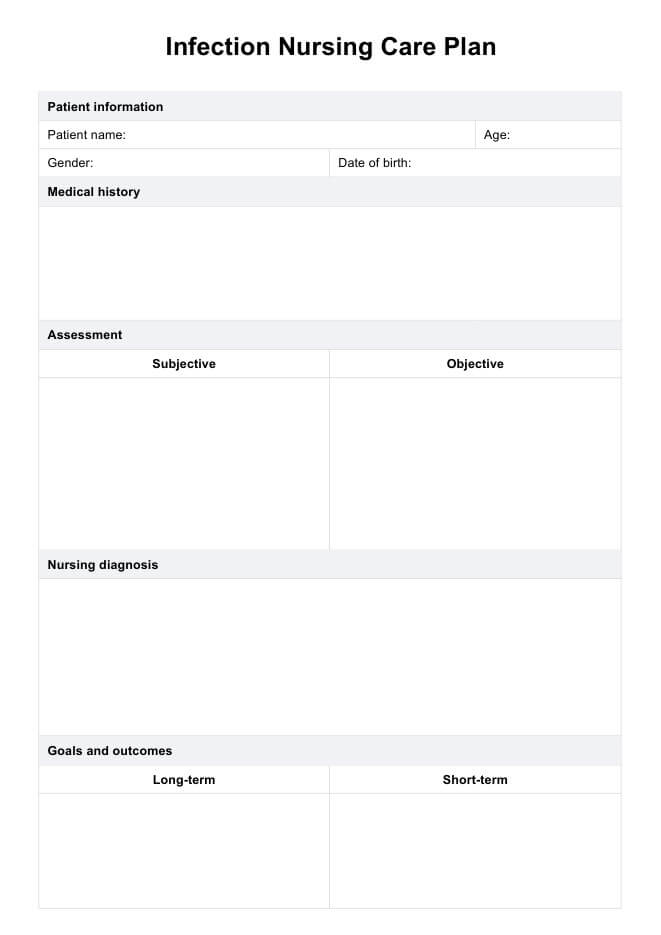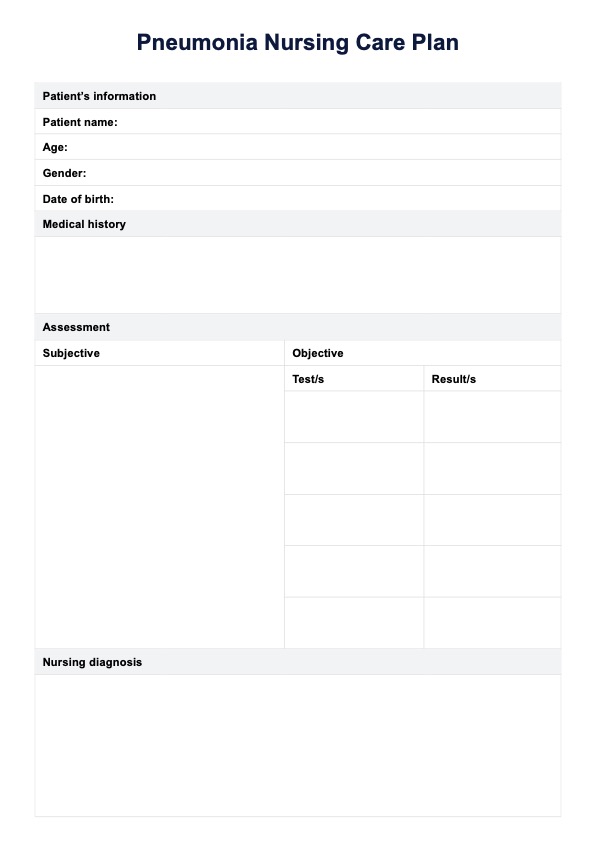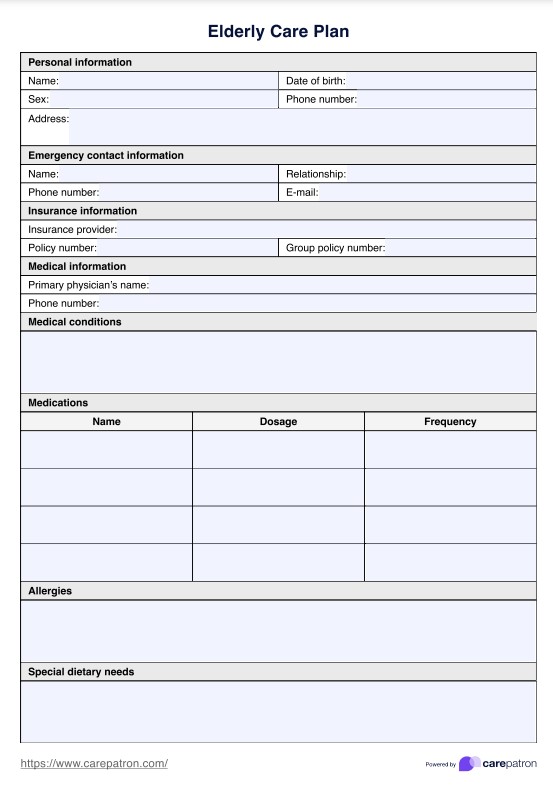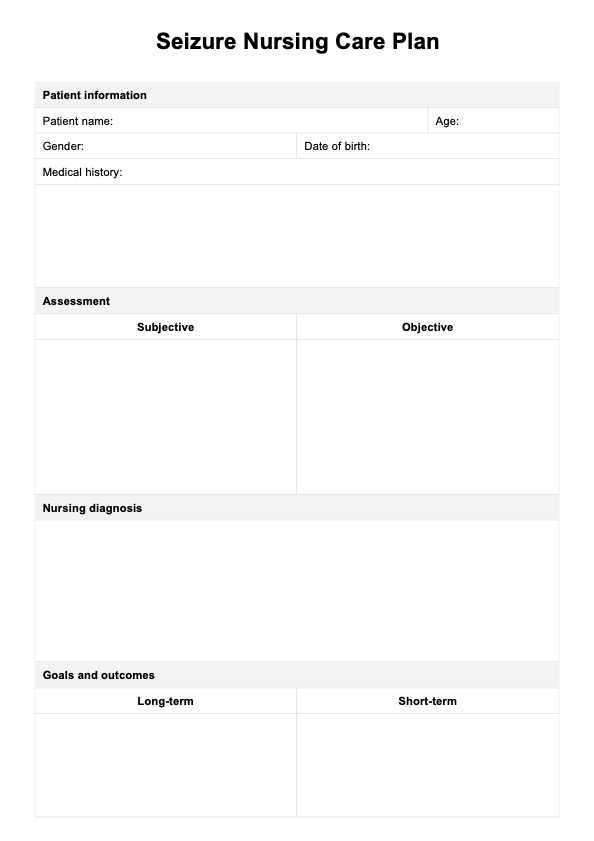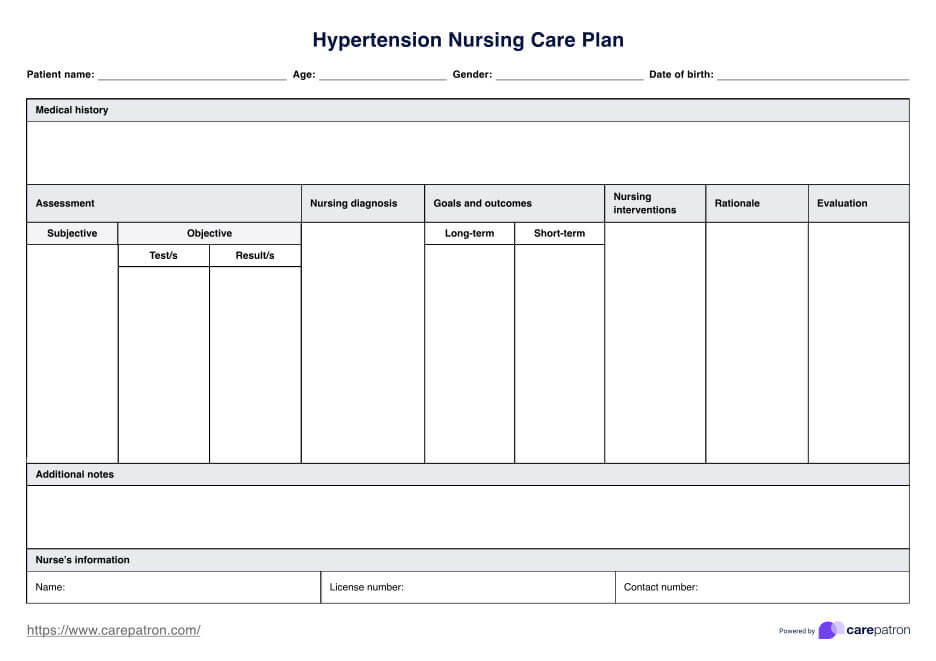Febersykepleieplan
Carepatron's free PDF download provides a template for nursing care planning. It helps you understand the nursing diagnoses associated with fever and how to provide adequate care for patients.


What is a fever?
A fever, simply put, is a temporary elevation in the body's temperature beyond the normal range. The body's normal temperature typically hovers around 98.6°F (37°C), but it can vary slightly from person to person. When the body detects a threat, such as an infection, it responds by increasing its core temperature as a defense mechanism.
Infections commonly trigger fevers as many bacteria and viruses struggle to survive at higher temperatures.
Causes of a fever
Several factors can contribute to an elevated body temperature, including bacterial or viral infections, heat exposure, or inflammatory conditions. The hypothalamus in the brain is responsible when the body temperature rises in response to these stimuli.
Below are some common causes of fever:
- Infections: Bacterial, viral, fungal, or parasitic infections can all lead to fever. Examples include influenza, urinary tract infections, pneumonia, and tuberculosis.
- Inflammatory conditions: Inflammation within the body, such as in autoimmune diseases like rheumatoid arthritis or inflammatory bowel disease, can result in fever.
- Heat exposure: Excessive exposure to high temperatures or heat stroke can cause the body's temperature to rise rapidly, leading to fever.
- Medications: Some medications, particularly those that affect the immune system or have known side effects of fever, can induce elevated body temperatures.
- Cancer: Certain types of cancer, such as leukemia or lymphoma, can cause fever as a result of the body's response to the malignancy.
- Vaccinations: Some individuals may experience a low-grade fever as a normal response to vaccines as the body mounts an immune response.
- Increased heat production: This occurs during vigorous physical activity or in cases of certain medical conditions.
Signs and symptoms of a fever
Recognizing the signs and symptoms of a fever is essential for prompt identification and management. Fevers often present with a combination of characteristic indicators. Here are some common signs and symptoms:
- Elevated core body temperature: The most obvious sign of a fever is an increase in body temperature above the normal range, typically measured with a thermometer.
- Chills and shivering: Many individuals with fever experience chills or shivering as their bodies attempt to generate heat to combat the elevated temperature.
- Sweating: As the body works to regulate its temperature, sweating may occur, leading to damp or clammy skin.
- Headache: Fever can often accompany headaches or migraines, contributing to discomfort and malaise.
- Fatigue and weakness: Fever can cause tiredness and weakness, impacting overall energy levels and daily activities.
- Body aches: Muscular discomfort or body aches are common symptoms of fever, often contributing to feelings of soreness or discomfort.
- Loss of appetite: Fever may suppress appetite, leading to decreased food intake and potential weight loss.
- Irritability or confusion: In some cases, particularly in children or older adults, fever may manifest as irritability, confusion, or altered mental status.
Fever Nursing Care Plan Template
Fever Nursing Care Plan Example
How do nurses assess and diagnose a fever
Assessing and diagnosing a fever is a critical aspect of nursing care. It requires a systematic approach to gathering information and identifying underlying causes. Nurses employ various techniques and tools to assess and diagnose fevers accurately, ensuring appropriate nursing interventions and patient care.
1. Initial assessment
Nurses begin by obtaining a comprehensive health history, including recent illnesses, medications, and exposure to infectious agents. They also assess vital signs, including temperature, heart rate, respiratory rate, and blood pressure. Comparing the patient's temperature to the normal body temperature range provides an initial indication of fever.
2. Temperature measurement
Depending on the patient's age, condition, and clinical setting, nurses use various methods to measure body temperature, such as oral, tympanic, axillary, or rectal thermometers. Obtaining a core temperature, considered the most accurate representation of body temperature, may be necessary for precise nursing diagnosis.
3. Physical examination
A thorough physical examination helps nurses identify additional signs and symptoms of fever, such as chills, sweating, or localized inflammation. Assessing for specific risk factors, such as recent travel or exposure to individuals with infectious diseases, aids in narrowing down potential causes.
4. Diagnostic tests
Depending on the clinical presentation and suspected underlying cause, nurses may order diagnostic tests, such as blood cultures, urinalysis, or imaging studies, to confirm or rule out bacterial infections or other contributing factors.
Next steps
Once a fever is assessed and diagnosed, nurses collaborate with healthcare providers to develop a comprehensive nursing care plan. This plan may include implementing appropriate nursing interventions to manage fever, monitoring vital signs, administering medications as prescribed, and educating patients on fever management and infection control measures. Regular reassessment of the patient's condition is essential to monitor response to treatment and adjust nursing care as needed.
How to use our Fever Nursing Care Plan template?
Our Fever Nursing Care Plan template is designed to assist medical practitioners in efficiently managing and treating patients with fevers. Follow these steps to utilize the template effectively:
Nursing assessment
Conduct a thorough nursing assessment to gather essential information about the patient's condition. Assess vital signs, including body temperature, heart rate, respiratory rate, and blood pressure. Identify any signs or symptoms suggestive of bacterial infection, such as localized inflammation or recent travel history.
Diagnosis and identification of underlying causes
Use the nursing diagnosis section of the template to diagnose the fever and identify potential underlying causes accurately. Consider factors such as impaired thermoregulatory function, bacterial infections, or acute brain injury that may contribute to fever development.
Nursing interventions
Select appropriate nursing interventions to address the patient's fever based on the assessment findings and diagnosis. We'll cover more of this in a later section.
Monitoring and evaluation
Continuously monitor the patient's response to nursing interventions and assess for any changes in symptoms or vital signs. Evaluate the effectiveness of the implemented nursing care plan in reducing fever and improving the patient's overall condition. Monitoring body temperature closely and identifying underlying causes, such as bacterial infections, are crucial aspects of fever management protocols.
Documentation
Thoroughly document all nursing assessments, interventions, and patient responses in the provided sections of the template. This documentation ensures continuity of care and facilitates communication among healthcare team members.
Common nursing interventions for a fever
Nurses play a crucial role in managing fevers and alleviating associated symptoms. Below are common nursing interventions employed in the care of patients with fever:
1. Administering antipyretic medications
Antipyretic medications, such as acetaminophen (Tylenol) or ibuprofen (Advil, Motrin), are often prescribed to reduce fever by lowering the body's temperature. These medications work by inhibiting the production of prostaglandins, which regulate body temperature. Nurses should carefully administer these medications according to the dosage and frequency, considering factors such as the patient's age, weight, and underlying health conditions.
2. Implementing physical cooling methods
Physical cooling methods can help lower body temperature and relieve fever-related discomfort. Tepid sponge baths, where the patient is gently sponge-bathed with lukewarm water, can reduce body temperature. Cooling blankets or packs may also be applied to specific body areas to regulate temperature. Nurses should closely monitor the patient's response to these interventions to prevent overcooling or adverse reactions.
3. Monitoring fluid intake and output
Fever can increase the body's demand for fluids, leading to dehydration if not adequately managed. Nurses should encourage patients to increase their fluid intake to prevent dehydration and maintain fluid balance. Monitoring fluid intake and output, including urine output and signs of dehydration such as dry mouth or decreased skin turgor, is essential. Intravenous (IV) fluid therapy may be necessary for patients unable to maintain adequate oral hydration.
4. Assessing for underlying causes
Identifying and addressing the underlying cause of the fever is essential for effective management. Nurses should conduct a thorough nursing assessment to evaluate signs and symptoms suggestive of bacterial or viral infections, inflammatory conditions, or other contributing factors. Diagnostic tests, such as blood cultures or imaging studies, may be ordered to confirm the diagnosis and guide treatment.
5. Providing comfort measures
Fever can be accompanied by chills, headache, muscle aches, and fatigue, significantly impacting the patient's comfort and well-being. Nurses should implement comfort measures, such as providing extra blankets for chills, administering pain relief medications for headaches and muscle aches, and ensuring a quiet and restful environment to promote relaxation and healing.
6. Educating patients and caregivers
Patient and caregiver education is crucial for empowering individuals to manage fever effectively at home and prevent complications. Nurses should provide information on fever management strategies, including when to seek medical attention, how to monitor for signs of worsening symptoms, and the importance of adhering to prescribed treatments. Education should be tailored to the patient's specific needs and preferences to ensure comprehension and adherence.
Benefits of having comprehensive care plans
Comprehensive care plans are essential tools in healthcare settings, providing structured guidelines for delivering high-quality patient care. Here are the benefits of having comprehensive care plans:
1. Improved patient outcomes:
Omfattende omsorgsplaner legger til rette for koordinert og helhetlig omsorgsleveranse, og forbedrer pasientresultatene. Ved å adressere flere aspekter av pasientbehandling, inkludert medisinske, sykepleie og psykososiale behov, hjelper disse planene med å optimalisere behandlingseffektiviteten og fremme raskere bedring.
2. Forbedret kommunikasjon og samarbeid:
Omsorgsplaner fungerer som kommunikasjonsverktøy, og sikrer at alle medlemmer av helseteamet er klar over pasientens mål, preferanser og omsorgskrav. Dette fremmer sømløst samarbeid mellom helsepersonell, noe som fører til mer effektiv omsorg og redusert risiko for feil eller utelatelser.
3. Personlig omsorgsleveranse:
Omfattende omsorgsplaner er skreddersydd for hver pasients individuelle behov og preferanser, noe som gir mulighet for personlig omsorg. Ved å vurdere faktorer som pasientens sykehistorie, kulturelle bakgrunn og sosiale støttenettverk, sikrer disse planene at intervensjoner er relevante og praktiske, og forbedrer pasienttilfredshet og engasjement i omsorg.
4. Standardisering av omsorgspraksis:
Omsorgsplaner gir standardiserte retningslinjer for evidensbasert omsorg, og fremmer konsistens og kvalitet på tvers av helsevesenet. Disse planene bidrar til å sikre at alle pasienter får optimal pleie uavhengig av omsorgsleverandør eller innstilling ved å skissere anbefalte inngrep, vurderinger, og overvåkingsparametere.
5. Effektiv ressursutnyttelse:
Omfattende omsorgsplaner bidrar til å optimalisere ressursutnyttelsen ved å veilede tildelingen av helseressurser basert på pasientens behov og prioriteringer. Ved å identifisere nødvendige inngrep og overvåke parametere på forhånd, minimerer disse planene unødvendige tester, prosedyrer og sykehusopphold, noe som fører til kostnadsbesparelser og forbedret helseeffektivitet.
Commonly asked questions
For det første administrerer de antipyretiske medisiner, for eksempel acetaminophen eller ibuprofen, for å redusere kroppstemperaturen og lindre ubehag. I tillegg implementerer sykepleiere fysiske avkjølingsmetoder, for eksempel lunkne svampbad eller påføring av kjøletepper, for å hjelpe til med temperaturreduksjon.
En vanlig sykepleiediagnose for feber er «risiko for ubalansert kroppstemperatur» relatert til kroppens manglende evne til å regulere temperaturen på grunn av infeksjon eller betennelse. Imidlertid er sykepleiediagnoser ikke like ofte brukt i kliniske omgivelser i det virkelige liv i dag.
Sykepleieintervensjoner for gul feber inkluderer støttende behandling for å håndtere symptomer som feber, kvalme og oppkast, sikre tilstrekkelig hydrering og væskebalanse, og overvåking for tegn på komplikasjoner som leverskade eller blødning.


